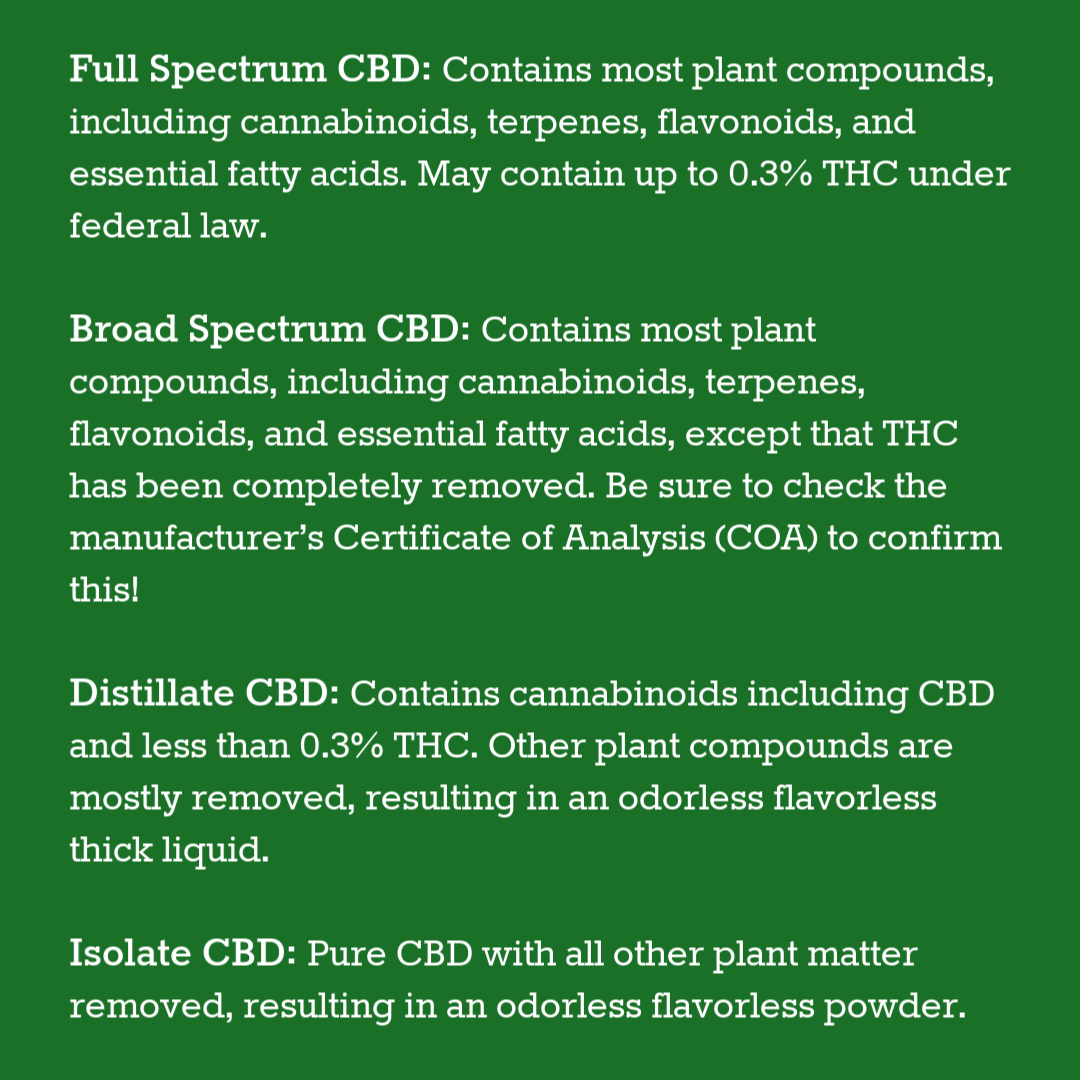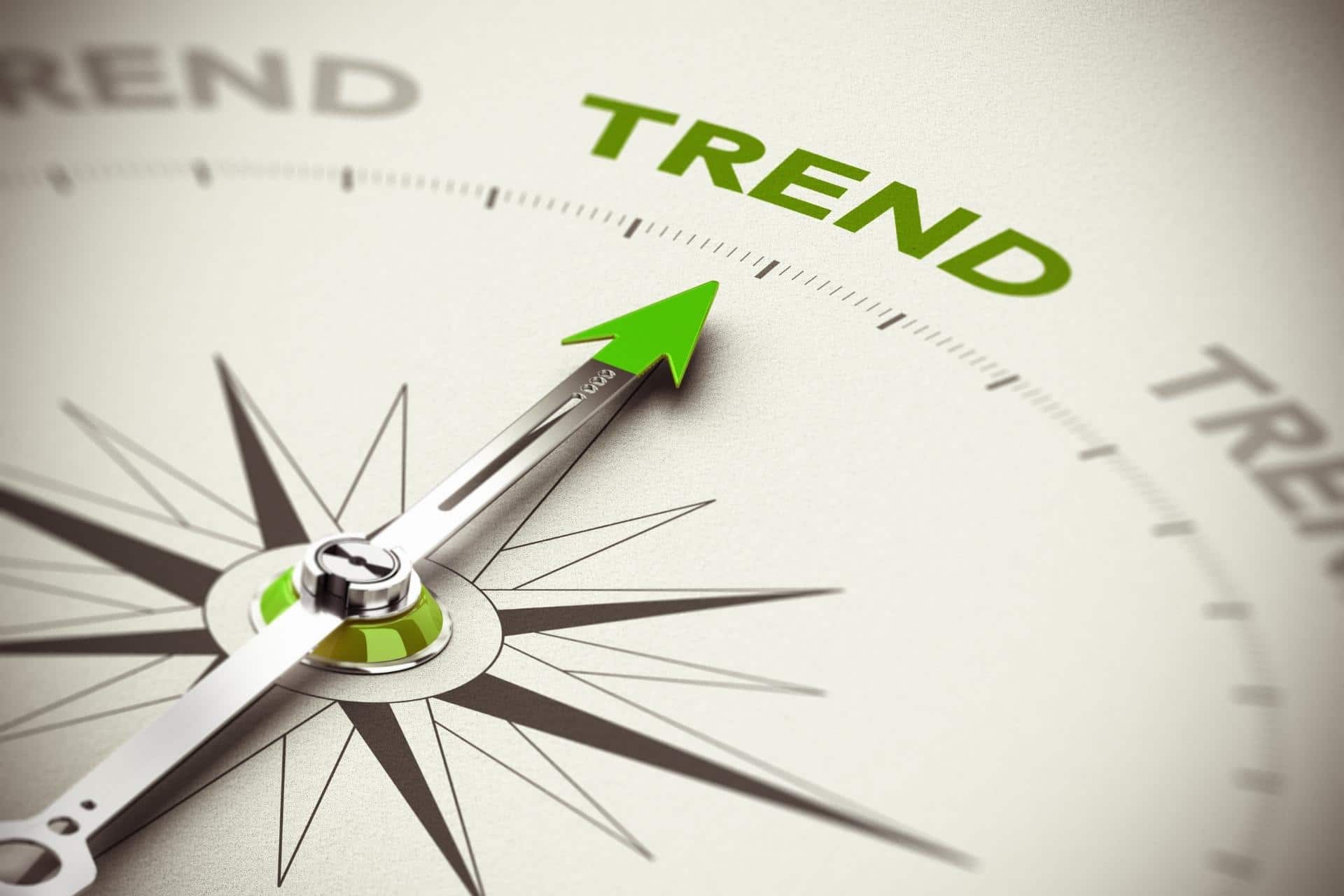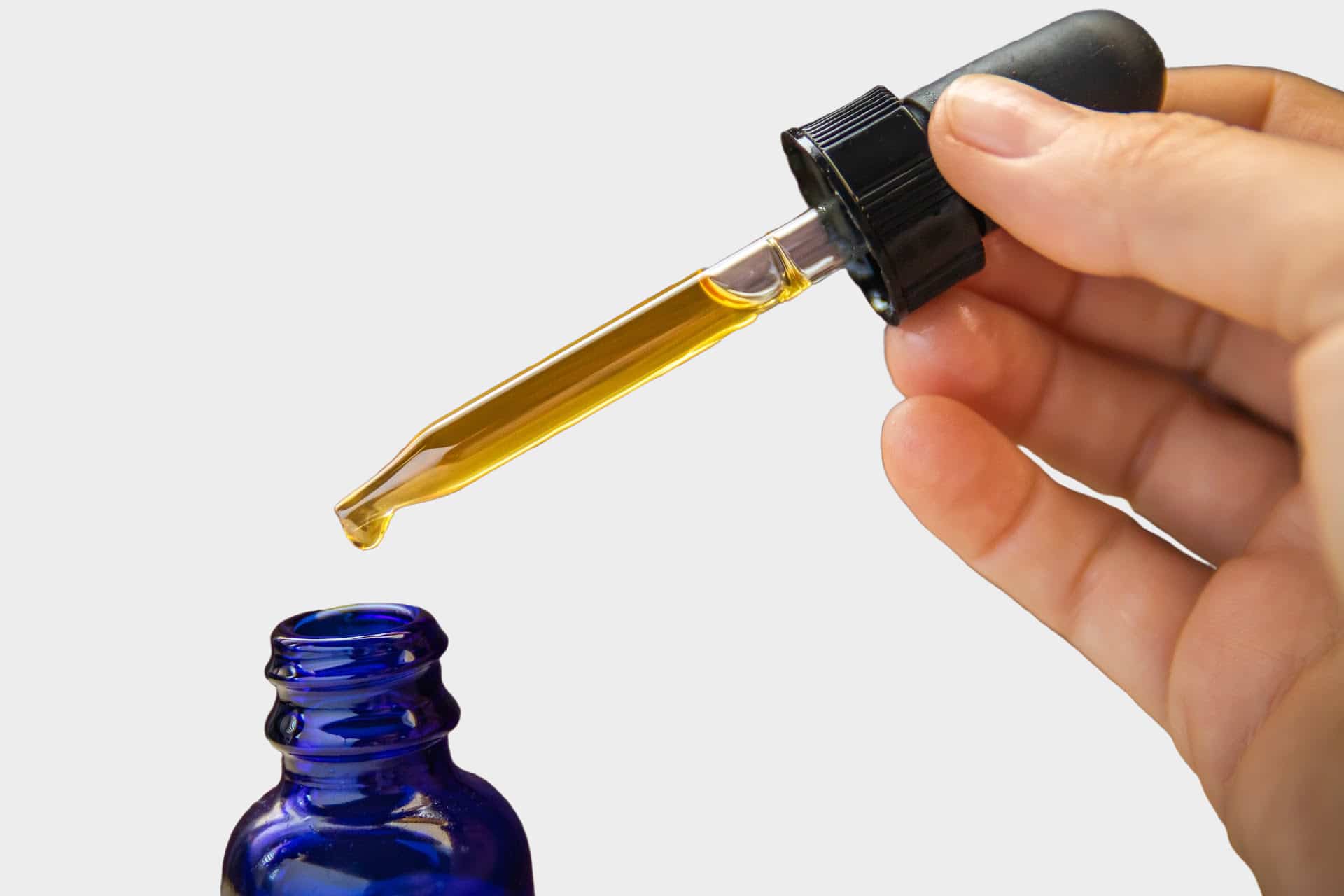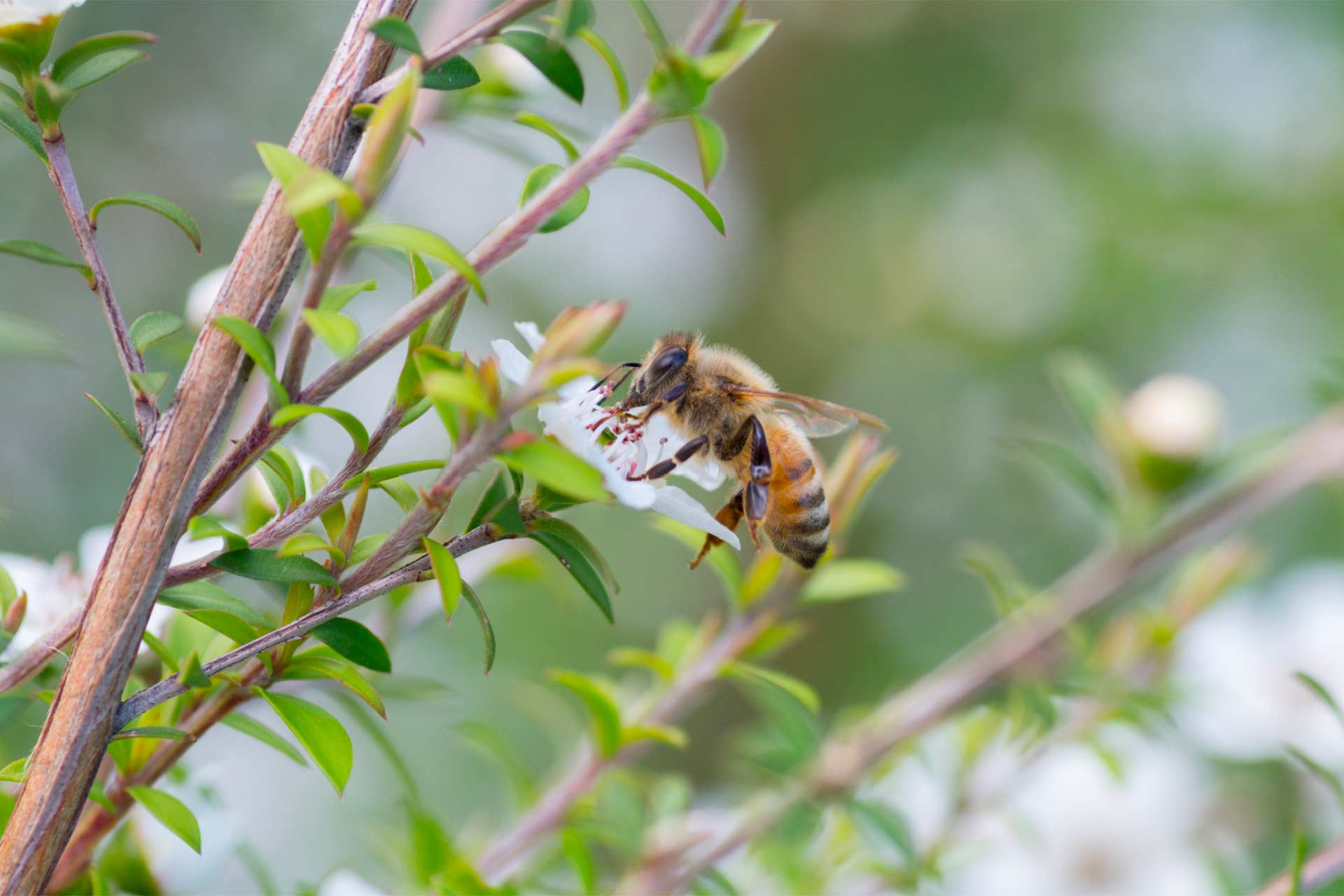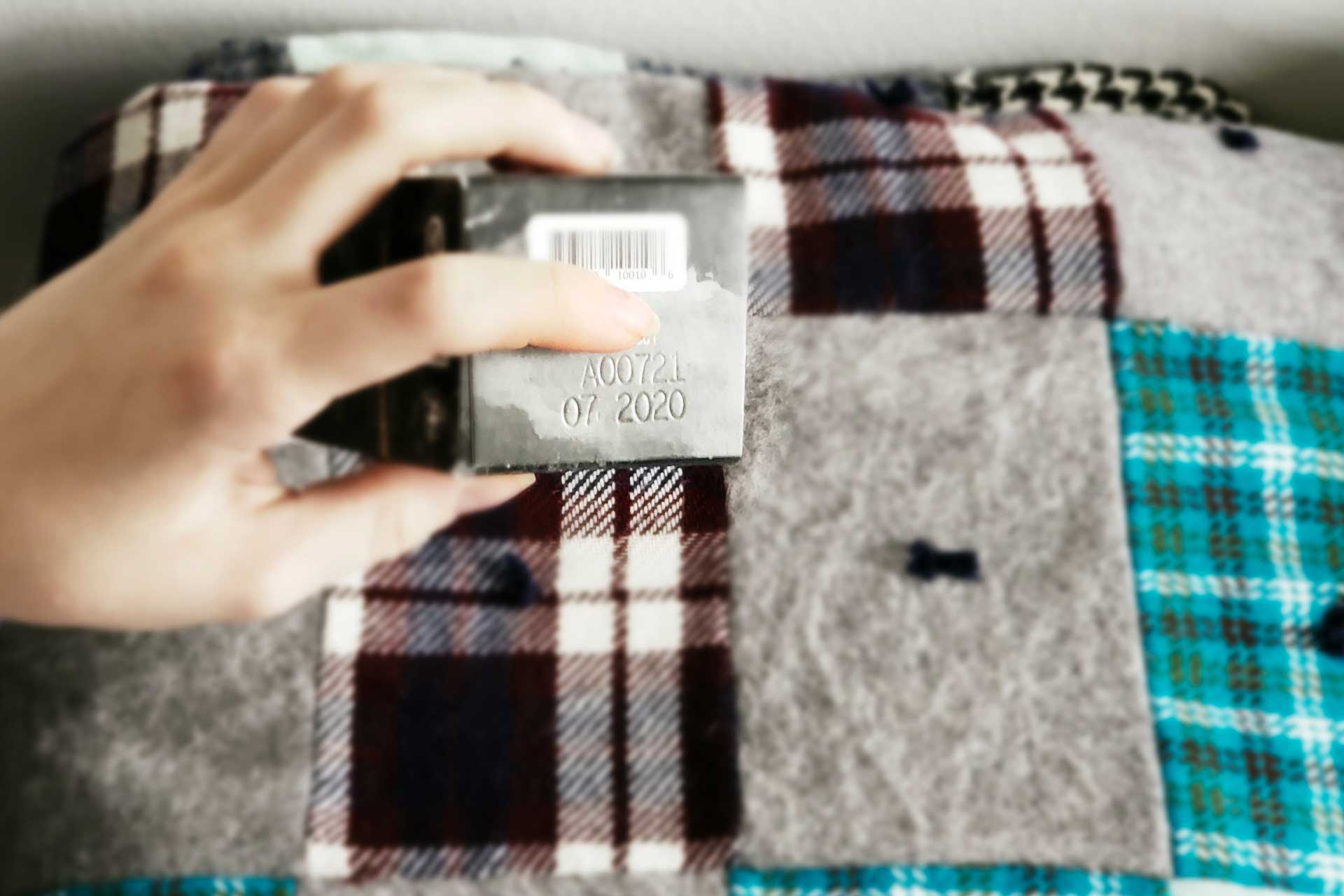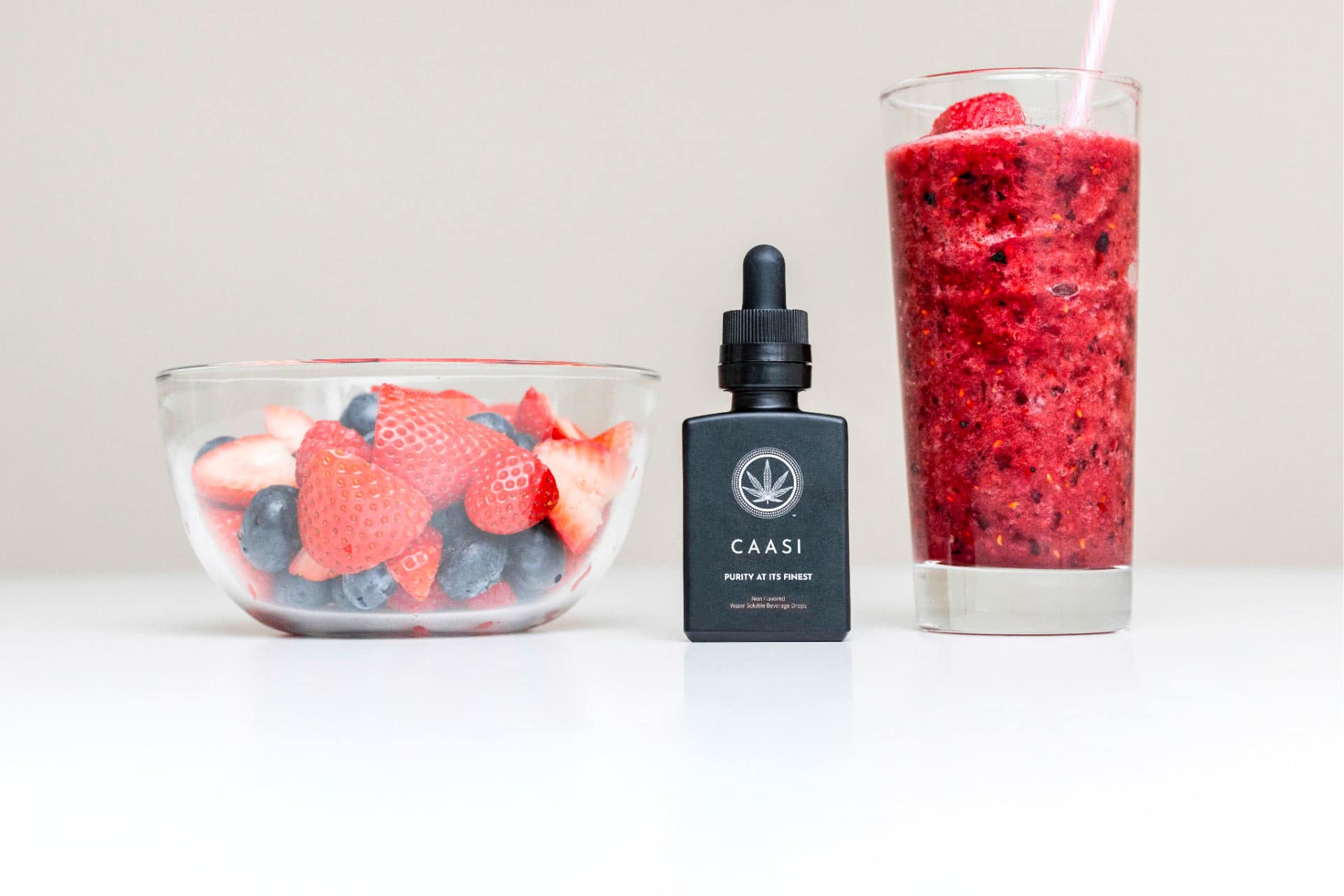Curious about CBD consumer trends in 2022?
Recent industry report shows need for consumer education on CBD, hemp and more
Medically reviewed by Katherine Golden, RN, and Eloise Theisen, NP
Written by Denise Rustning
Cannabis analytics firm BDSA released new Consumer Insights data on CBD consumption trends in February 2022. While the data are geared toward a business audience, we thought our Leaf411 followers might appreciate a quick look at some highlights, along with Leaf411’s unique insights on current trends based on the patients and consumers we serve on our guidance line.
Consumers lack education on using CBD
One of BDSA’s top findings was just how little CBD consumers know about the products they’re using. According to the BDSA Consumer Insights report, about 40% of CBD consumers rely on friends and family as their main source of information on CBD. Yet 30% of these consumers haven’t heard of terpenes, and 10% haven’t heard the term “cannabinoids.” Cannabinoids, including CBD, CBG, CBN and others, are core to hemp and marijuana’s beneficial effects, while terpenes play a vital role in the plant’s entourage effect. A basic understanding of these plant compounds can go a long way when it comes to finding the best product for your needs.
The BDSA report doesn’t surprise us at Leaf411. Our own data show that about 40% of our calls are focused on Plant 101. We sometimes even hear inaccurate information from callers who “heard it from a friend.”
At Leaf411, we hope to be part of the solution. The BDSA report mentioned the need for brands and retailers to improve their educational outreach–we can help! If you’re a hemp CBD or cannabis brand looking to level up your consumer education game, reach out to us or consider joining Leaf411 as a business member which brings benefits for both your brand and your consumers. Click here to learn more.

Using CBD for health and wellness? You’re not alone!
According to BDSA’s report, CBD consumers cite health and wellness as their primary reason for purchasing CBD. When it comes to specific uses, pain relief tops the list, with better sleep, stress management and anxiety management rounding out BDSA’s top four list.
While our Leaf411 caller data cuts across both hemp CBD and cannabis, we can also say that pain tops our list of conditions that callers contact us about, followed by mental health issues including anxiety and stress, and sleep issues. While the order is a bit different from BDSA’s findings, the conclusion is clear–many people are seeking alternatives for relief when it comes to these issues!

Smoke it? Not when it comes to CBD for most users
BDSA’s Consumer Insights report found that the majority of CBD consumers (around 75%) are using CBD edibles, with CBD topicals coming in second place. Only one-third of consumers report consuming CBD inhalable products including vapes, concentrates and flower.
There may be various reasons for the dominance of this CBD product format:
- CBD edibles offer a user-friendly format for new consumers who are familiar with other orally-ingested products like vitamin gummies.
- CBD edibles are portable and discreet, providing benefits without noticeable smells or smoke.
- The smokeless format may appeal to consumers’ concerns about respiratory health during the pandemic
- CBD edibles are shelf-stable and fit with other retail products sold by health foods stores, grocery stores and other general goods stores.
- CBD edibles are readily available when compared to hemp CBD flower and concentrates which can be difficult to find.
Whether you prefer edibles, topicals or inhalable products, we have fully-vetted business members who offer a wide range of hemp CBD products–visit our business member directory to learn more.
Our fully-licensed Leaf registered nurses (RNs) can also help guide you to the optimal product format for your needs, reducing the need for trial-and-error which saves you both money and time. Click this link to get started scheduling your call.
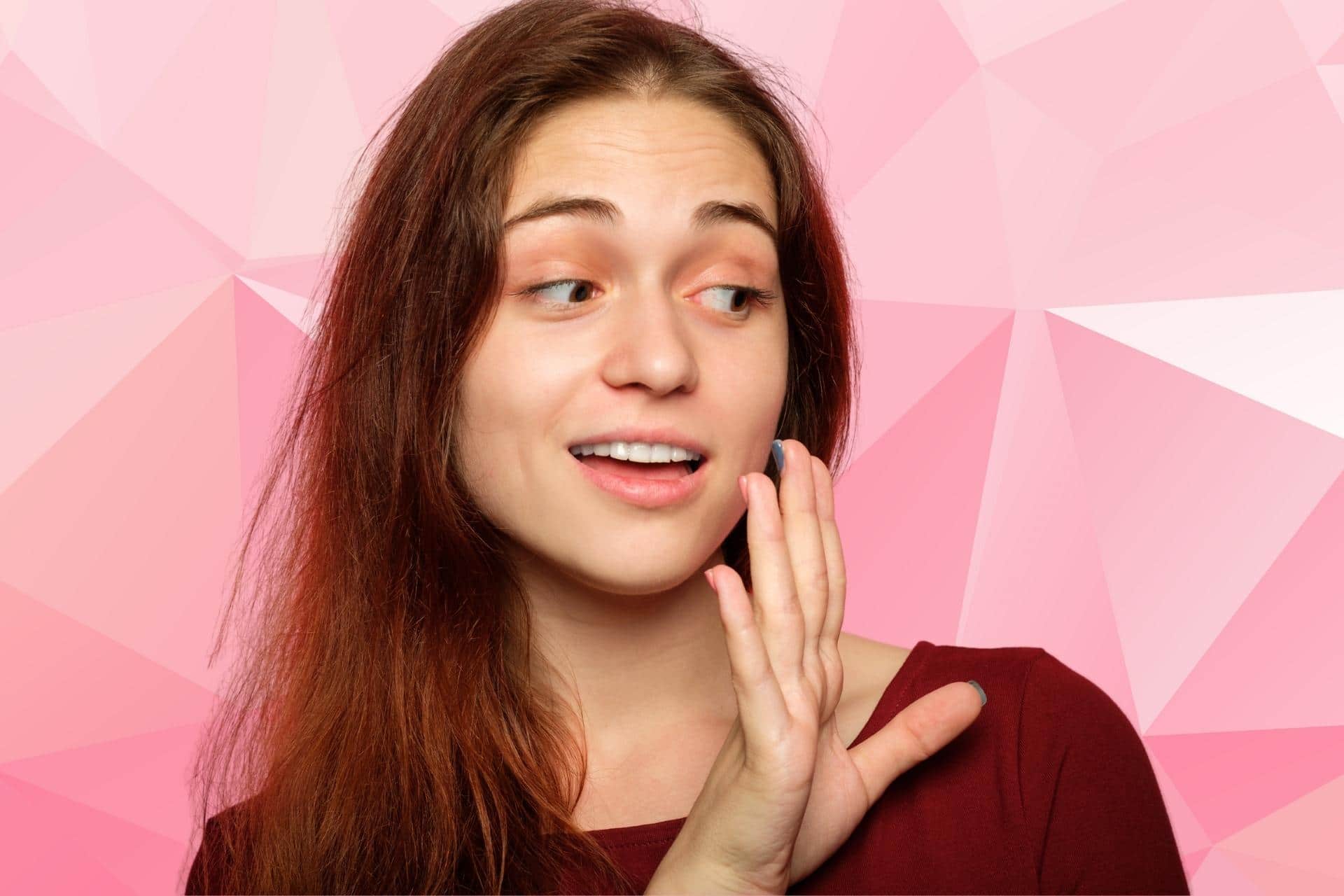

Assortment of CBD and THC products including Elixinol Omega Turmeric and CBD; KOR Calm CBD sublingual spray; 1906 Love milk chocolate edibles with 5mg THC and 5mg CBD; Wana Quick Pina Colada Gummies with 5mg THC; Altus Juicy Pear Gummies with 10mg THC; trupura Relief Cream with broad spectrum CBD; Seed & Smith Purple Punch strain flower; and a PAX Era Pro used for vaping cannabis oil extracts.
Many people use both hemp CBD and cannabis
Nearly two-thirds (65%) of CBD consumers also consume cannabis containing higher amounts of THC, according to BDSA’s report.
At Leaf411, a little over one-third (36%) of our callers report previous use of both cannabis and CBD hemp, a noticeable difference from BDSA’s Consumer Insights data. Keep in mind that the BDSA report is looking at a broad cross-section of consumers (purchases made), while Leaf411’s callers represent consumers (both thinking about a first-time purchase or have already made a purchase) seeking clinical information or guidance around specific issues.
Our Leaf nurses are here to help with your questions about CBD!
Click this link for our online scheduling service and find a day and time for your Leaf nurse guidance call. Every day our Leaf RNs help consumers and patients at all levels, from canna-curious people who’ve never used CBD or THC before, to experienced users looking for the best cannabis options to address specific health concerns.
Interested in joining Leaf411 as a business member and supporting our mission to improve access to trustworthy information and guidance on plant-based medicine? Visit our Business Membership page to learn the benefits of supporting Leaf411.
The Leaf411 cannabis nurse hotline provides education and directional support to the general public about the safe use of legal cannabis. We partner with select business members who meet our rigorous standards to extend our education and outreach efforts.

Exploring the Benefits of CBDA in Hemp Products
Exploring the Benefits of CBDA in Hemp Products
Leaf411 member Myriam’s Hemp shares insights on CBDA and the importance of hemp consumer education
Medically reviewed by Katherine Golden, RN, and Eloise Theisen, NP
Written by Denise Rustning
We recently talked with Myriam’s Hemp Co-Founder and CEO Diana Peña about the company’s wide range of hemp products. The brand offers hemp topicals as well as tinctures featuring CBD, CBG, CBN and CBDA, as well as an Enhanced CBD Full Extract Cannabis Oil (FECO) packed with hemp plant compounds. Myriam’s Hemp also creates custom blends for customers with unique terpene profiles.
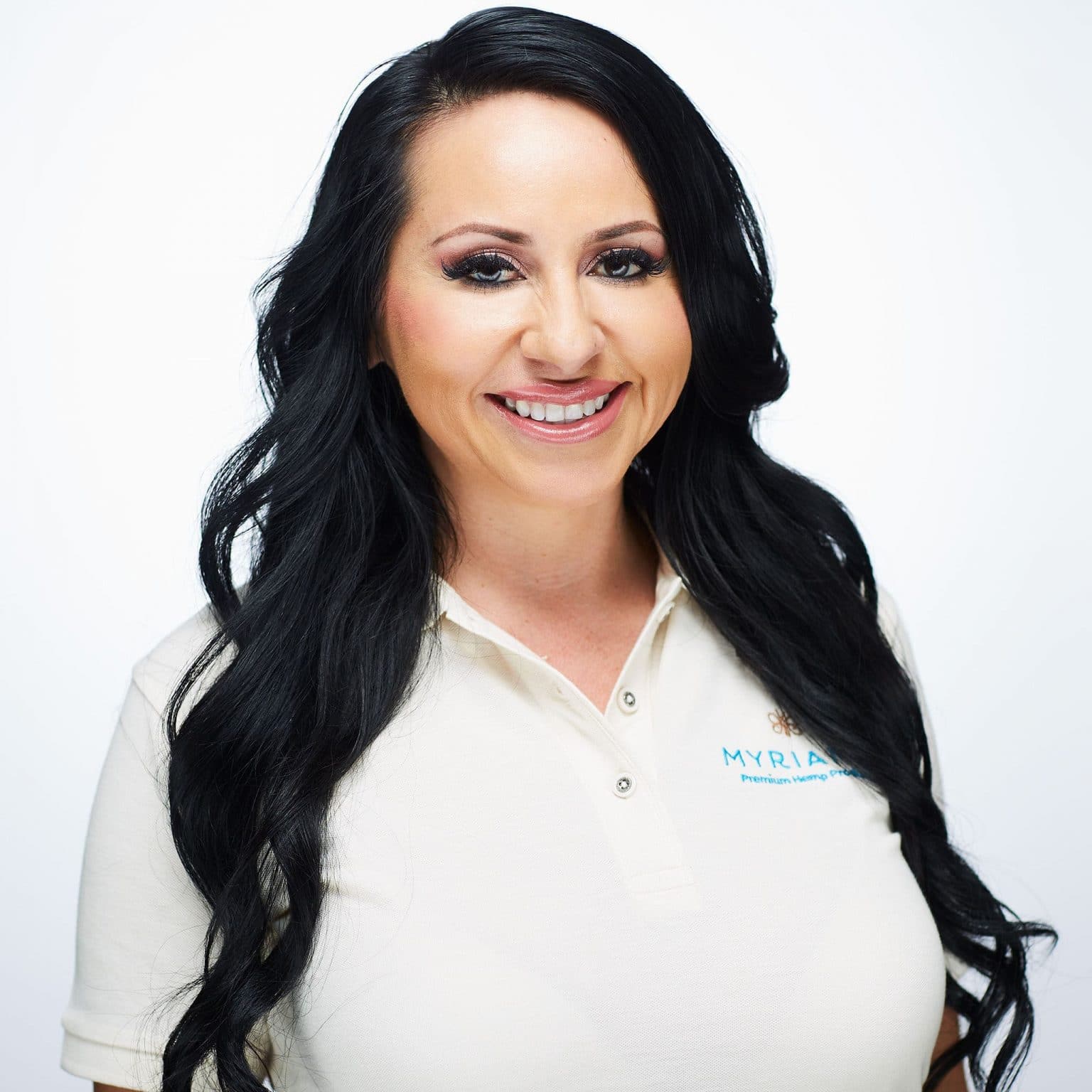
Diana Peña, Co-Founder and CEO of Myriam’s Hemp
When we asked Diana which of the cannabinoids she felt was most underrated, she was quick to respond.
“People are paying more attention to the different cannabinoids found in hemp and how they deliver different results. However, the product that we’ve always carried at Myriam’s Hemp and that I still think to this day that doesn’t get enough attention is CBDA,” said Myriam.
We’re guessing that many of you have never heard of CBDA (it’s different than CBD!) and thought it would make a great topic for today’s blog post after talking with Diana. We’ll also share tips for finding hemp products that truly deliver the CBDA and other cannabinoids they claim to contain.
Hemp is more than just CBD: Understanding hemp’s beneficial compounds
Usually when people discuss hemp, they’re talking about CBD (cannabidiol), but in fact, the hemp plant contains hundreds of plant compounds including other minor cannabinoids, terpenes, flavonoids and essential fatty acids (a good fat!).
Understanding different cannabinoids can make all the difference when it comes to finding the best hemp product for your needs, whether you’re seeking relief or boosting overall wellness. In fact, you might have even tried a few of the minor cannabinoids—for example, CBN (cannabinol) or CBG (cannabigerol), though chances are that you’ve not heard as much about CBDA.

CBDA: The precursor to the more well-known CBD
CBD itself is no slouch, with many people finding that CBD is a powerful tool when it comes to health concerns.
But did you know that CBD doesn’t start out as CBD in hemp/cannabis plants? In fact, the compound starts out as CBDA (cannabidiolic acid) which is found in fresh raw hemp and cannabis.
When CBDA is exposed to heat over 110 degrees Celsius (230 degrees Fahrenheit), it converts to CBD. The scientific term for this process is “decarboxylation.” Typically, decarboxylation occurs either during the extraction process or when someone smokes, vapes or cooks with the hemp flower, heating it up to over 110 degrees Celsius.
However, some hemp extraction techniques don’t involve heat. When these extraction techniques are used, CBDA may remain in the hemp product.
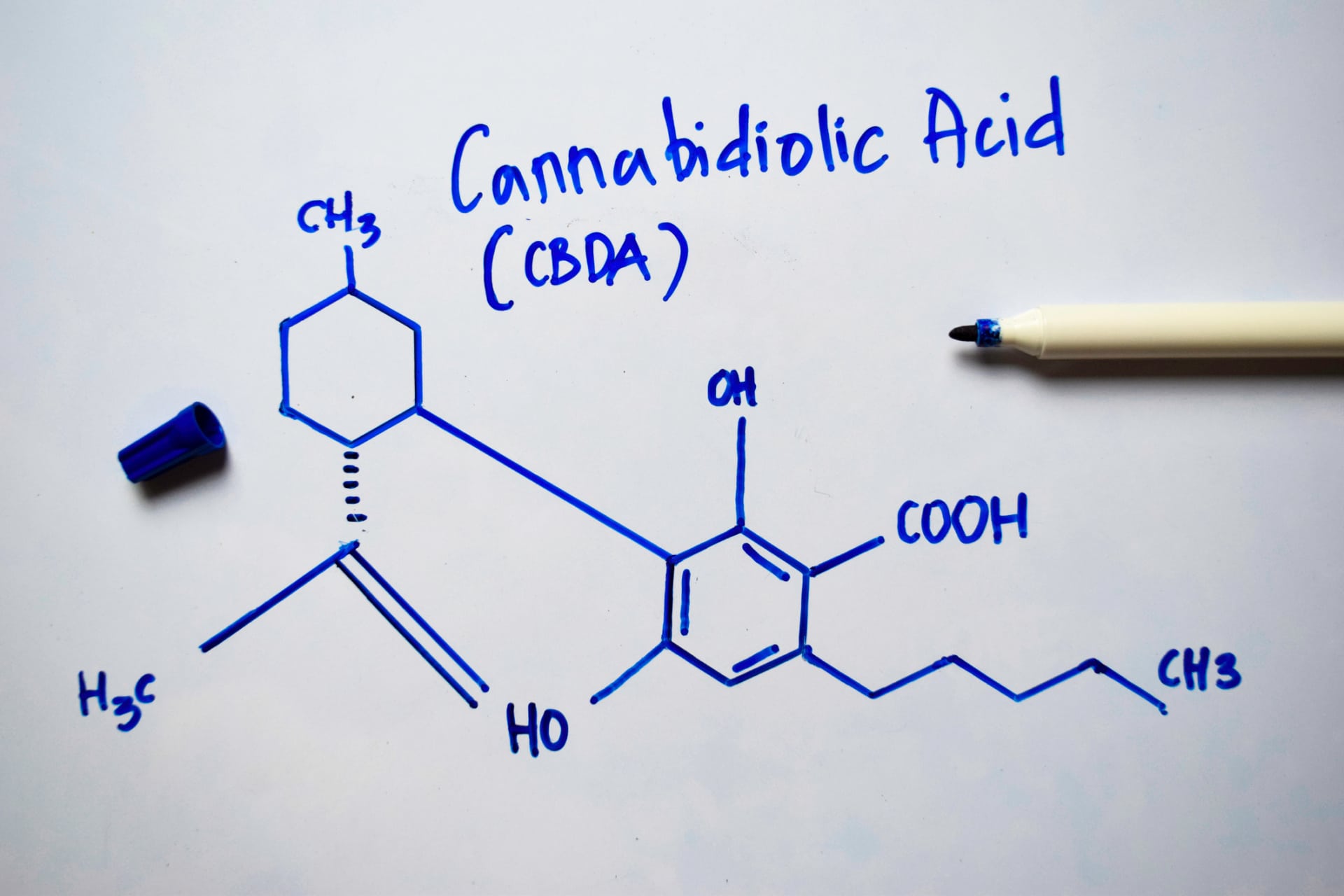
Is CBDA better than CBD?
CBDA works differently in your body than CBD. How? CBDA has a different mechanism of action. Instead of binding directly to CB1 or CB2 receptors found in the body’s endocannabinoid system, CBDA acts on COX-2 receptors which play a role in inflammation as well as 5-HT receptors which produce serotonin.
CBDA’s different mechanisms of action means that it provides different and wide ranging results which are currently being researched to better understand its potential. CBDA may also be far more potent than CBD when it comes to managing nausea and vomiting based on research that Dr. Ethan Russo shared in a review published last year.
While most research shows that THC is best for nausea, someone could start with CBDA if they are adverse to THC, or if they live in an area where cannabis is not legal. Our Leaf411 nurses suggest CBDA is best for anticipatory nausea.
CBDA may help in other ways as well. At Myriam’s Hemp, Diana hears from customers who say that CBDA works well to help with multiple concerns.
“Some people have various ailments—they’re not just dealing with anxiety, but have anxiety, inflammation, pain and mood swings all happening at the same time. Those are the customers we hear from who tell us that CBDA has been especially helpful for them.”
CBDA is thought to be more water-soluble than CBD and in turn is more bioavailable, meaning that CBDA can be more effective at lower doses compared to CBD. This might address how it may be “better” or more effective than CBD. The lower doses can help people avoid side effects that may come with higher doses of CBD and it can be more cost effective.
At Leaf411 we suggest there may be a potential to use CBDA as a first line treatment option due to the lower doses needed for possible symptom relief. There is less research on CBDA metabolism so we always suggest approaching it with caution. If THC is a barrier to a new cannabis user, CBDA could be an option as well due to easier access and again lower doses which could mean less side effects and drug-to-drug interactions.

How to make sure you’re getting high quality CBDA
Hemp products containing beneficial amounts of CBDA can be challenging to find. Obviously, when you shop for a CBDA product, you’ll want to make sure that it contains the cannabinoids being advertised.
How do you do that?
Look for companies that regularly test their hemp products via an independent third party laboratory. Test results will be provided as a product Certificate of Analysis (COA) showing the different percentages and amounts (usually milligrams per gram or “mg/g”) of cannabinoids in the tincture, edible, topical or other product. For example, the first page of Myriam’s Hemp COA for their CBDA tincture batch #2138 is shown below listing cannabinoids found in their tincture.
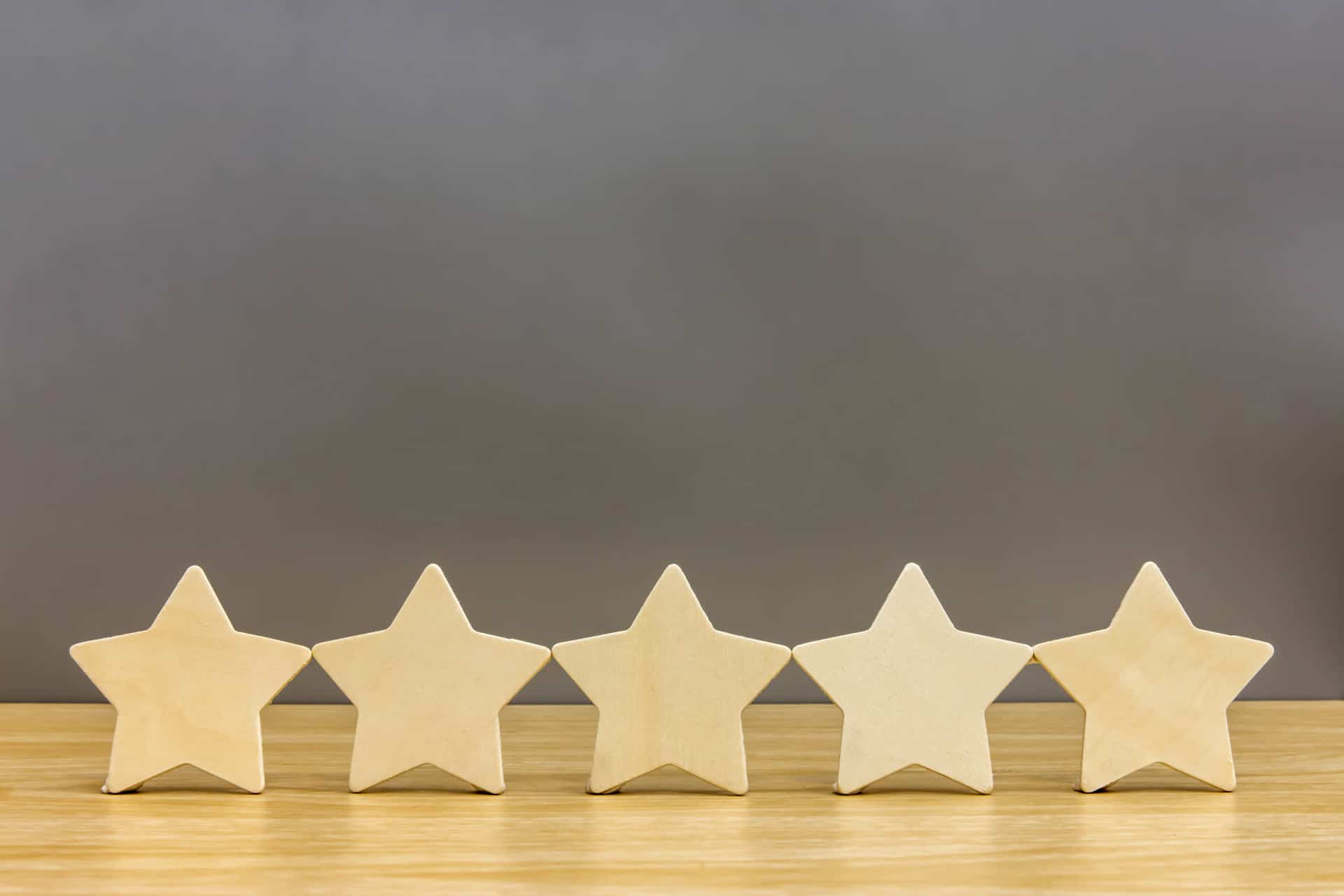
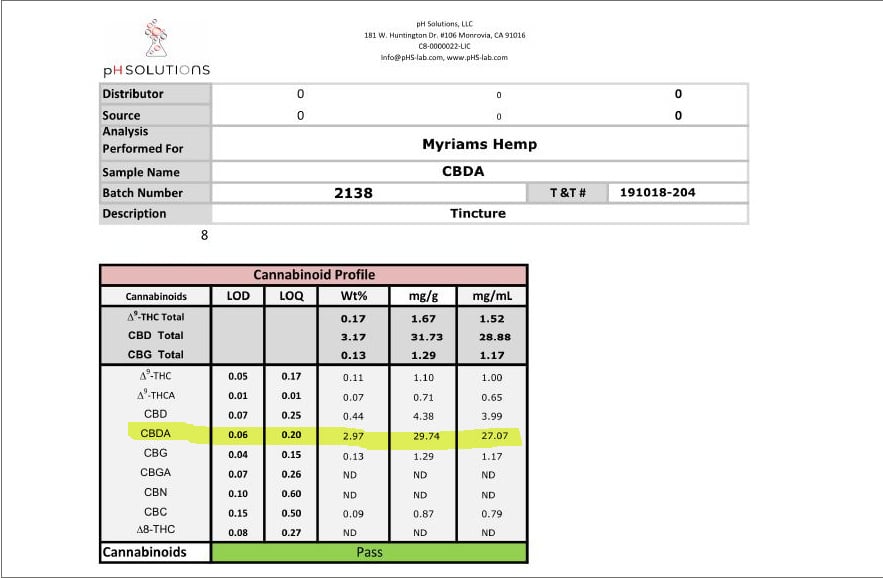
Screenshot of the top portion of Myriam’s Hemp CBDA Certificate of Analysis. The COA also shows results for terpenes and potential contaminants, and is available on the product page.
Some manufacturers like Myriam’s Hemp go beyond the basic tests to also include lab results for potential contaminants like solvents, heavy metals and molds. This voluntary extra level of testing helps ensure product purity for consumers.
When it comes to Myriam’s Hemp full spectrum CBD tincture, the brand even includes lab results showing the amount of beneficial terpenes in the oil.
Beyond independently lab-testing every lot, Myriam’s Hemp has built a long-term relationship with an Oregon organic hemp grower to ensure consistency and reliability in the plants that are grown for the brand. This attention to detail really sets Myriam’s Hemp apart from other hemp brands that may get their raw materials from the cheapest source, with little regard for product consistency.
Exploring Myriam’s Hemp’s full range of products, including the new Sunshine Orange flavor
In addition to CBDA, Myriam’s Hemp also offers tinctures featuring CBG, CBN or CBD and Enhanced CBD Full Extract Cannabis Oil (FECO), along with CBD balms and pet CBD.
Tinctures are available in unflavored olive oil, natural vanilla flavor or the new natural Sunrise Orange flavor. When ordering a tincture, you also have an option to add a terpene boost designed to promote specific effects, including calm, focus, energy or immunity.
The company can also formulate custom blends with unique cannabinoid and terpene profiles personalized to individual needs. For more information about how to customize your product, click on this link.
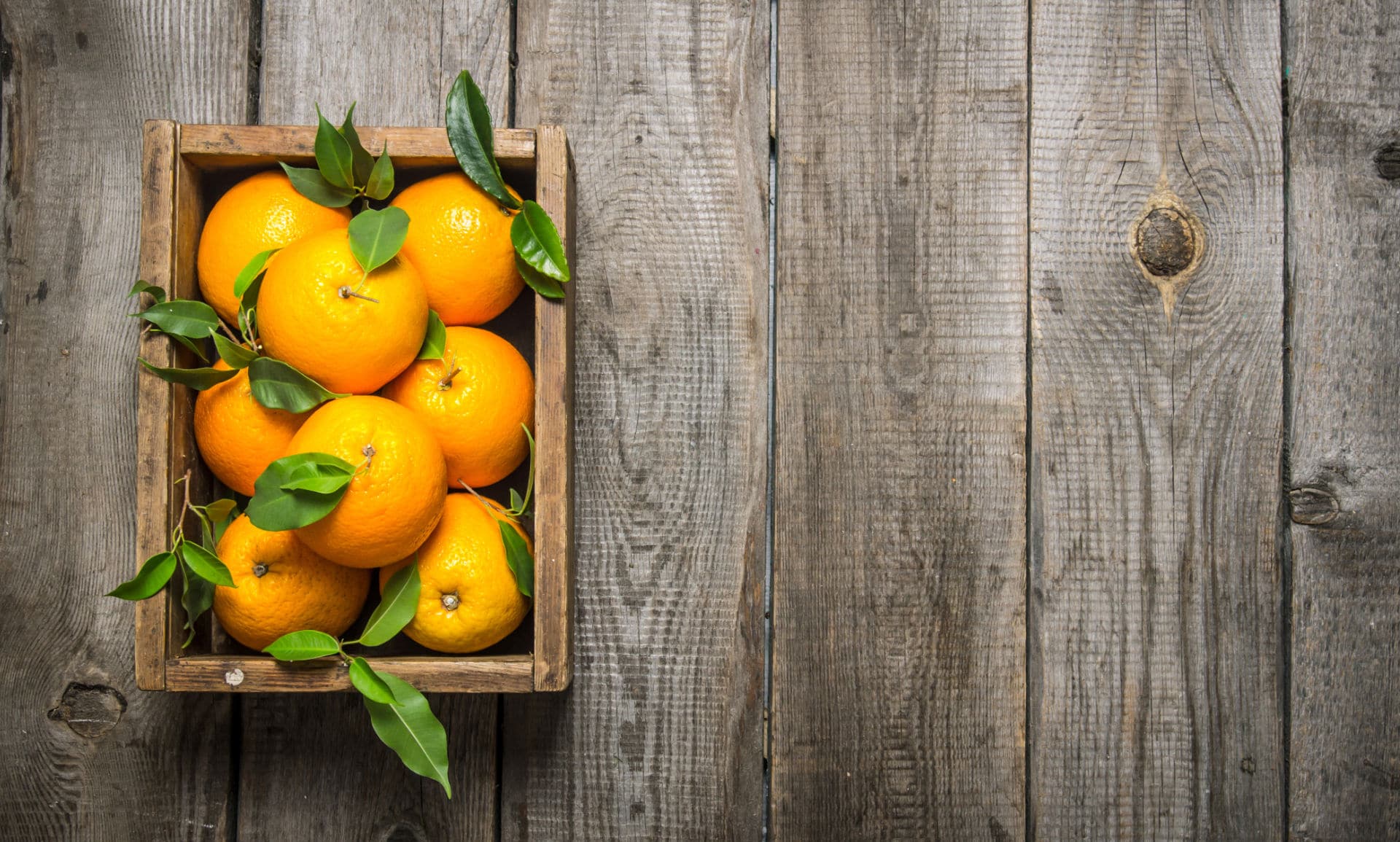
A personal connection to the healing power of hemp and cannabis
Talking about CBDA, COAs and product quality can leave you feeling a bit overwhelmed. At Leaf411, we understand! All of our Leaf411 staff have been there before, not sure where to start with investigating the therapeutic potential of hemp.
In fact, Diana shares a similar story as our own co-founder, Katherine Golden, RN, when it comes to a family member’s health concern that brought Diana to the hemp space.
In 2013, Diana’s mother Myriam was diagnosed with an inoperable brain tumor which launched the family on an exhaustive search for alternatives to manage Myriam’s pain and improve her quality of life while facing a terminal condition. The family’s journey ultimately led to the creation of Myriam’s Hemp with a focus on providing consistent product quality and transparency to other patients and consumers who were also seeking plant-based alternatives.
From their own experience seeking out plant-based alternatives for an ill family member, the Myriam’s Hemp team knows that education is incredibly important when it comes to targeting specific cannabinoids to health goals.


Example of CBD journaling taken from Myriam Hemp’s Facebook page.
How much CBDA, CBG, CBN, or CBD should you take?
While Diana is comfortable talking about the unique features of each of their hemp products, when it comes to dosing, she is thankful to have Leaf411 as a resource to share with consumers.
“We provide a lot of education on our website and provide general information about starting low and going slow with hemp products,” said Diana. “However when it comes to individual questions about dosing, we refer consumers to the Leaf411 nurses who have the education and research to lead the consumer in the right direction.”
Some consumers reach out to Myriam’s Hemp wanting a thorough medical consultation, but Diana notes the cost may be prohibitive to many people.
“We have some really great doctors we can send people to, but to be honest with you, some of them are very expensive, up to between $600 and hour and $750 an hour. A lot of people can’t afford that,” Diana says. “Leaf411 helps fill the gap by providing free clinical guidance to patients who might otherwise be left to try and figure out everything on their own.”
Myriam’s Hemp supports Leaf411 as a business member to ensure the public has access to clinically-sound guidance at no cost, as one of many ways the company supports consumers.
In fact, Diana points to the brand’s customer support as another element that really makes Myriam’s Hemp stand apart from the competition.
“We get feedback from customers saying that other companies do not provide the same level of help and information that we provide,” Diana says. “I’m always happy to hear that type of feedback, because we have worked hard to make sure our own staff is really knowledgeable and able to help.”
Myriam’s Hemp also offers a Compassion Program for veterans, seniors, and people who may struggle with the cost of plant medicine, based on the belief that “good health should never be out of reach.”
Let our expert Leaf411 nurses help with your hemp questions
Our Leaf411 hotline nurses are knowledgeable about the wide range of hemp products available today, and are ready to answer your questions about the best options for your health and wellness needs, whether that’s CBD, CBDA, CBG, CBN or other cannabinoids. Our nurses also help with dosing, identifying potential medicine interactions and troubleshooting when a hemp product isn’t providing the anticipated effects. Best of all, our service is FREE to callers, built on the belief that cannabis education should be accessible to all. Call 844-LEAF411 (844-532-3411) or chat us from our home page during hotline hours, Monday-Friday from 8:00 a.m. to 7:00 p.m. MDT.
Also, if you share our belief that knowledge is power when it comes to plant-based medicine and want to support our mission, we encourage you to visit our fundraising campaign at: https://www.classy.org/campaign/leaf411/c350217
The Leaf411 cannabis nurse hotline provides free, anonymous education and directional support to the general public about the safe use of legal cannabis. We partner with select business members who meet our rigorous standards to extend our education and outreach efforts.

CBD and Workplace Drug Testing
Can hemp CBD make you fail a drug test? It depends.
Medically reviewed by Katherine Golden, RN, and Eloise Theisen, NP
Written by Denise Rustning
Our Leaf nurses recently heard from several upset callers who unknowingly tested positive for THC on workplace drug tests, despite limiting their use to hemp CBD products. How did this happen? What can you do to reduce your risk of failing a drug test as a result of legal CBD use?

Natural hemp contains trace amounts of THC
Hemp is actually a form of cannabis that has been cultivated for specific characteristics, including high levels of cannabidiol (CBD) as well as very low levels of Delta-9 tetrahydrocannabinol (THC). Federal law requires legal hemp plants to test at under 0.3% THC on a dry weight basis. This hemp plant matter is then used to make the CBD tinctures, gummies, creams and other products that many of us rely upon for wellness and relief.
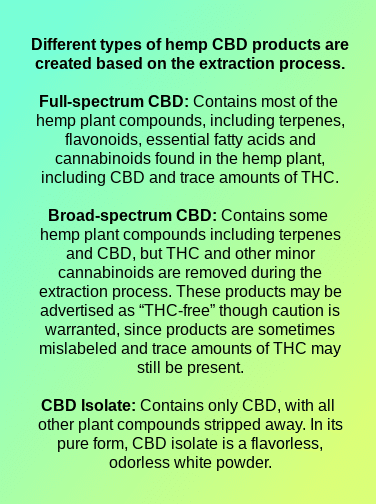
How much THC are you really getting in your hemp CBD?
The product you are taking may meet the legal limit for a hemp CBD product because it registers at 0.3% dry weight of THC. But after processing and packaging, the amount of THC per milliliter may exceed that amount.
Our Leaf nurses have seen many products on the hemp CBD market that are over 1-2 milligrams of THC per milliliter (1 milliliter is typically one dropper full).
Unfortunately many consumers may start off consuming 1-2 droppers full of full-spectrum hemp instead of a lower dose due to limited education when they purchased the product. As a result, they may unknowingly test positive on a drug screen because they are actually consuming 1-2 milligrams of THC on a regular basis.
Wouldn’t a consumer feel it if they were ingesting a couple of milligrams of THC? Sometimes yes and that’s why we have callers complaining that a CBD hemp product made them “high.” Not everyone will feel this type of effect, though, due to the low dose and fact that CBD impacts how THC is absorbed when both are taken together.
How to read a hemp CBD Certificate of Analysis (COA)
You may be wondering about the hemp products in your own cabinet, wondering where you can find information on the amount of THC in your full-spectrum CBD. The best place to look is the product’s Certificate of Analysis (COA) showing lab results from third-party testing.
- The amount of THC (milligrams per gram or “mg/g”) number is typically the last row on the right hand side (see example below).
- This number, mg/g, is approximately the same as milligrams per milliliter–in other words, the amount of THC that you will get per each milliliter (mL) dropperful. (Visit this article to learn more about volume conversion between different cannabis products.)
- Looking at the example COA below, you would expect to get about 0.4 mg of THC in each dropperful of the hemp tincture that was tested.

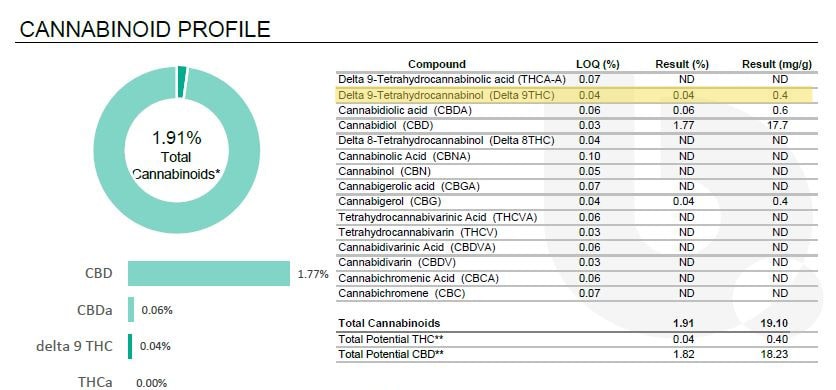
Screenshot from a third-party testing lab Certificate of Analysis (COA) for Elixinol’s Everyday Daily Balance Full-Spectrum CBD Tincture, showing CBD content as well as trace amounts of Delta-9 THC and other minor cannabinoids.
Understanding how much THC is really in your hemp is one part of the puzzle when it comes to potential drug testing. Another clue can be found in how those small amounts of THC are stored in your body, building up over time, when assessing whether your hemp use puts you at risk of failing a workplace drug test.
Leaf411 understands how complicated understanding medical formulations can be and that’s where our hotline nurses can help! If you have your COA in hand, our nurses will do the math for you and figure out the amount of THC you are taking with each dose. Call 844-LEAF411 (844-532-3411) or chat us from our home page during hotline hours, Monday-Friday from 8:00 a.m. to 7:00 p.m. MDT for help in understanding COAs and hemp CBD dosing, at no cost to you.
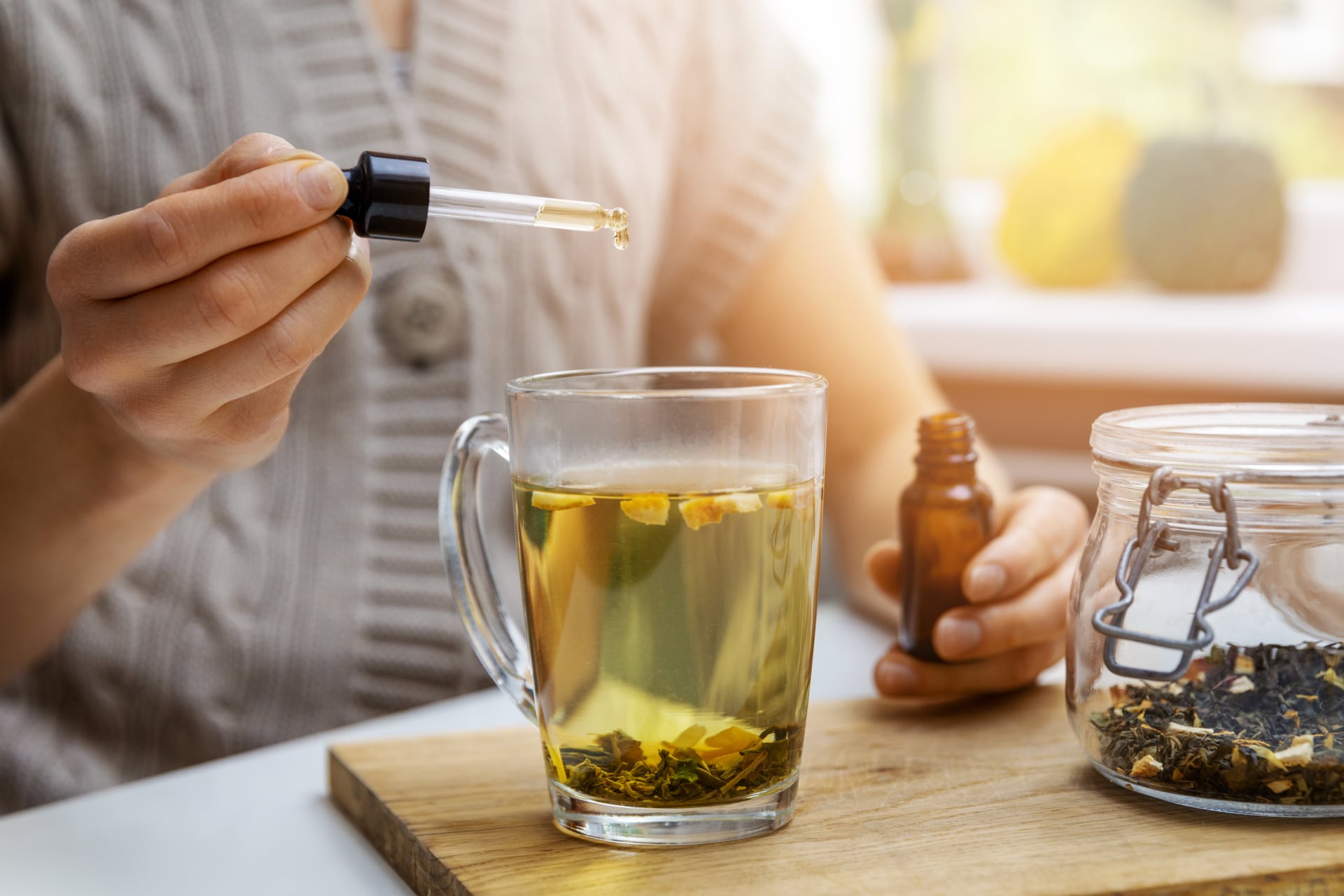
Understanding how THC is stored in the body
Many people prefer full-spectrum hemp CBD, finding it provides better quality symptom management for them than broad-spectrum or CBD isolate products.
With full-spectrum CBD, different plant compounds including minor cannabinoids and small amounts of Delta-9 THC are believed to work together to create an entourage effect. In other words, all the plant compounds working together have a stronger effect than any one compound would have by itself.
THC levels in full-spectrum hemp CBD products are low. However, they can pose potential risks when it comes to workplace drug testing.
Why is that?
When you ingest full-spectrum hemp either orally or through inhalation (smoking or vaping), the trace amounts of Delta-9 THC breaks down into non-active metabolites (THC-COOH) that stay in your system for days or even weeks. While these non-active metabolites don’t make you “high,” they are the markers of cannabis use that urine drug tests look for as evidence of previous cannabis use.
These THC-COOH metabolites accumulate or build up in your system over time, stored in fat cells until they are more slowly excreted, showing up in urine and saliva.
As we just mentioned, this buildup of THC-COOH does not cause intoxication or any other side effects, and is not a problem for most people–unless they are subject to drug testing.
In fact, the American Cannabis Nurses Association (ACNA) has come out against urine-based workplace drug testing due to the fact these tests are unreliable and do not accurately measure on-the-job impairment, with positive test results negatively impacting nurses and other workers who use hemp CBD and cannabis responsibly and legally while off the clock. Click on this link to download the full ACNA resolution regarding workplace drug testing of nurses for cannabis.
Do small amounts of THC from full-spectrum hemp build up to a detectable level?
Unfortunately, research is sparse on how small amounts of THC-COOH metabolites accumulate in full-spectrum hemp CBD users.
In regular cannabis users consuming higher-THC products, we know that these THC-COOH metabolites can stick around for up to a month following discontinuation of daily marijuana use, based on research.
We can also assume that even though the amount of THC in full-spectrum hemp is very small, it will accumulate in daily hemp users the same way that larger amounts accumulate in marijuana users, stored in fat cells with levels of THC-COOH increasing over time.
This is one plausible explanation for recent calls our hotline has received from daily hemp users who failed workplace drug tests based on the levels of the THC-COOH metabolite in their urine, even though they were using an average daily dose of full-spectrum CBD. We’ll discuss what amounts of THC-COOH the drug tests look for further down in this blog post.
Also, it is important to note that workplace drug tests look for evidence of Delta-9 THC, not other cannabinoids like CBD, CBN, or even hemp-derived Delta-8 THC which is created through a chemical process. (Learn more about Delta-8 here https://leaf411.org/answering-your-delta-8-questions/.)


Hemp CBD product quality matters
When investigating why hemp users may fail workplace drug tests, another potential issue comes up as well—product quality.
The hemp CBD product market is largely unregulated for now, putting the onus on the consumer to research product quality and trustworthiness.
The most powerful tool available to a consumer is the product Certificate of Analysis (COA) from a third-party laboratory (i.e. the product is not tested by the company itself); however, lab testing and COAs are completely voluntary for hemp manufacturers, and hemp lab testing technology lacks precision when it comes to very small amounts of cannabinoids when compared to drug testing technology. (To learn more about COAs, what they show and how to read them, we suggest checking out the article and video at this link.)
You can usually find product COAs on the manufacturer’s website, checking them out before you purchase a product.
We took a quick look at some of our Leaf411 hemp CBD members’ sites, and found that links to the COAs may be found either on the top menu or on the bottom of the main website, as well as on product pages themselves. You can also directly contact a manufacturer to request the COA for a particular product. If they don’t offer COAs, it might be best to keep looking for a different brand that does.
Product COAs provide a good start. If you’re buying from an established high-quality brand, you can be more confident that the COA can be trusted. Unfortunately some shady brands have been known to make fake COAs for their products.
Keep in mind, though, that a lack of standards across different third-party labs as well as the natural variability in plant-based products can result in cannabinoid levels that fluctuate between product lots or even individual product items, meaning that even honest companies face challenges in accurately reflecting the amount of THC in their products.
The U.S. Food and Drug Administration (FDA) recently tested 147 hemp CBD products on the market, with some surprising findings:
- Over half (108) of the products did not contain the amount of CBD listed on the label. Of those, 18% contained significantly less CBD than advertised, and 37% contained significantly more CBD than advertised.
- Nearly half the products contained THC levels above the limit of quantitation (LOQ), which is 3.1 mg per serving.
(Read the FDA summary in pdf format here.)
In other words, even reputable companies face challenges in accurately reporting precise test results, and less savory CBD companies often take advantage of the lack of standardized testing to sell products that don’t come near their product label claims.
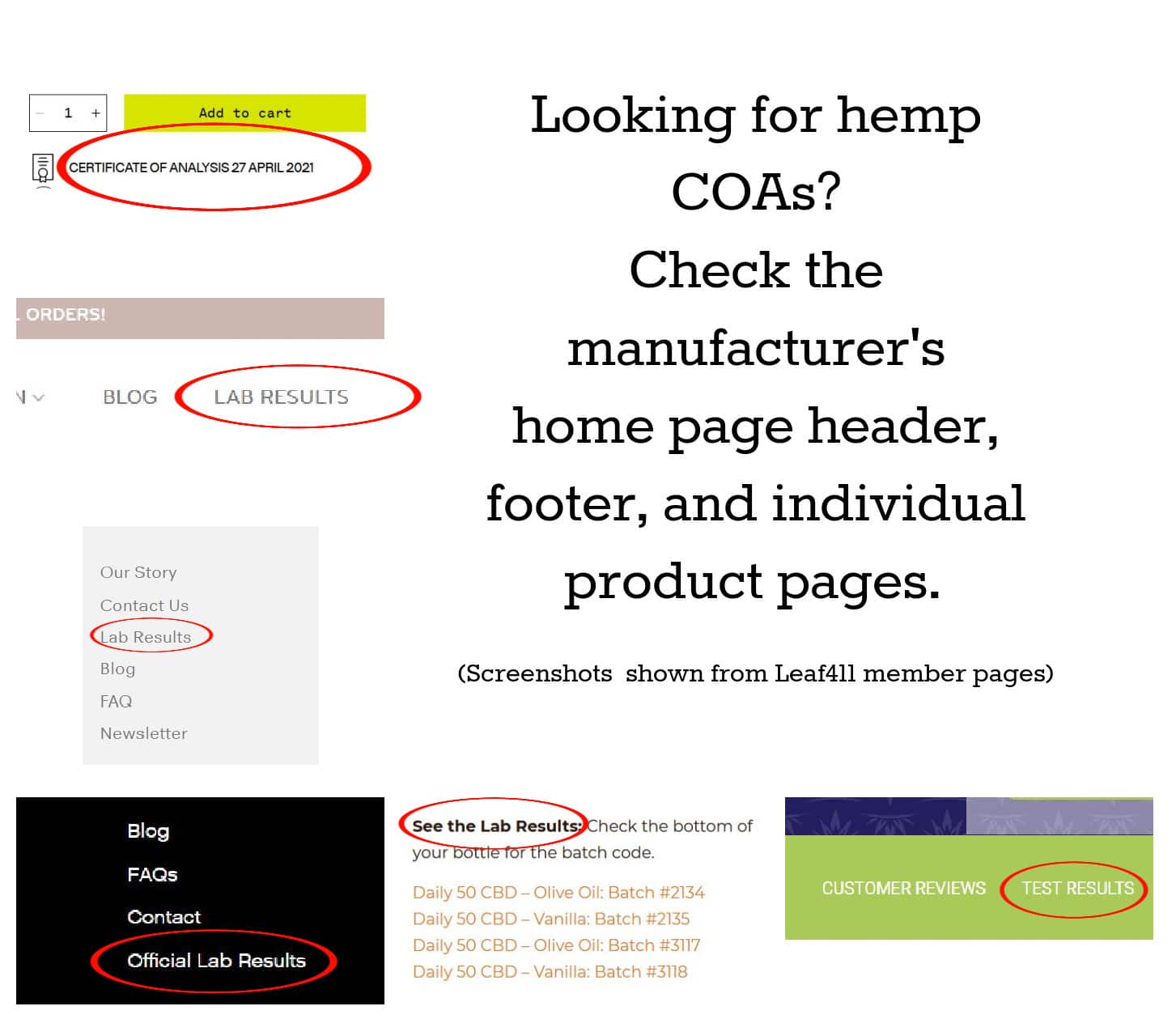
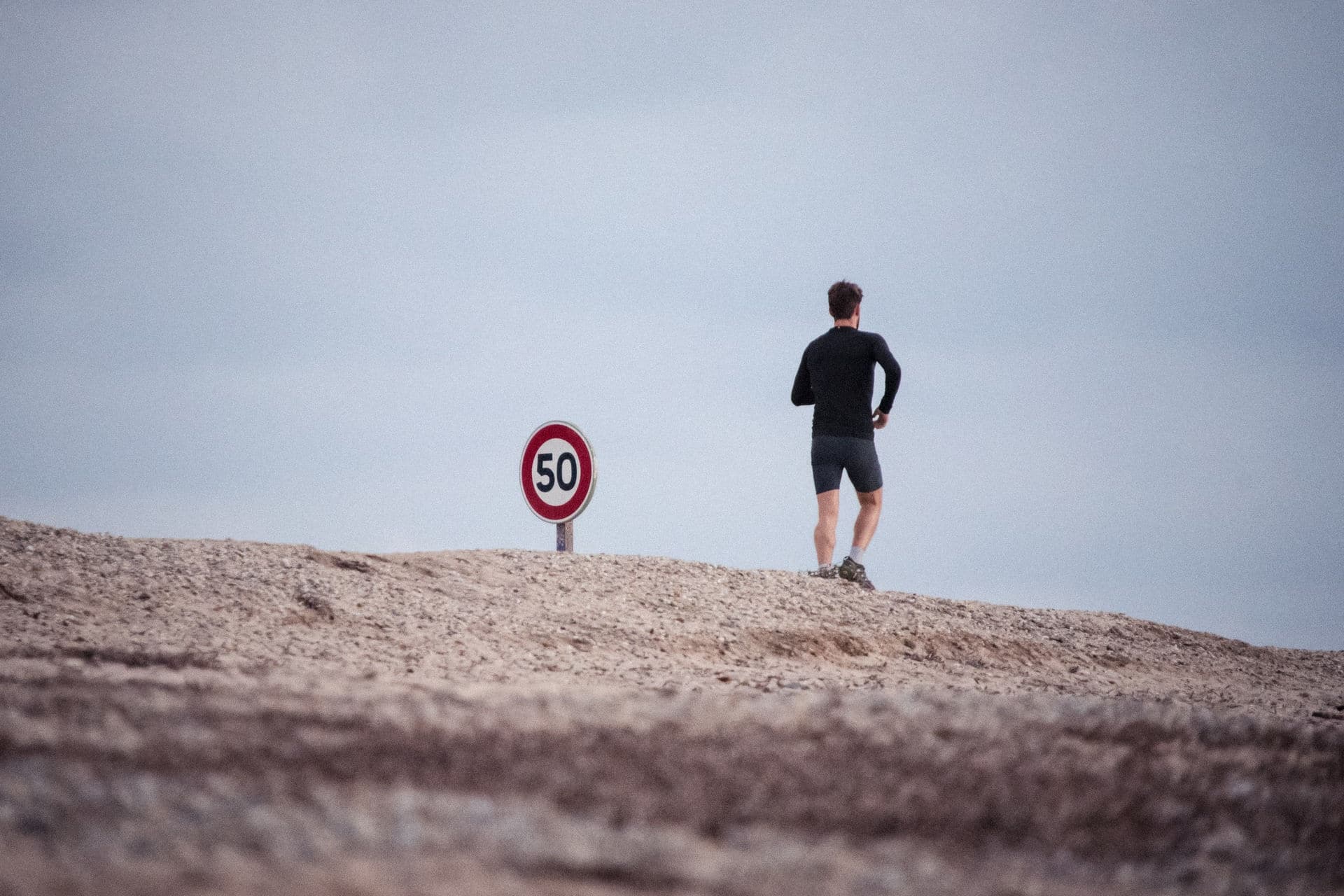
What are your workplace drug testing policies?
We’ve talked a lot about the CBD and THC cannabinoids in full-spectrum hemp, and how THC-COOH metabolites are stored in the body. Now, let’s turn to the urinalysis drug testing process, a topic we’ve written about before, but geared more toward marijuana users.
Most workplace drug tests, as well as the federal Department of Transportation (DOT), use a 50ng/ml limit for presence of THC-COOH metabolites. Hit that number or any higher, and you will fail the test.
In fact, drug testing laboratories are even able to test urine for lower levels of THC-COOH metabolites, at either a “sensitive” level of 20ng/ml, or an “extra-sensitive” level of 15ng/ml.
Is it possible for regular, responsible full-spectrum hemp use to put someone over the 50ng/ml limit? Based on recent calls to our hotline, we believe so.
Leaf411’s guidance for hemp CBD users who are subject to drug testing
- Be proactive. Take a look at your daily hemp CBD regimen, including all tinctures, gummies, beverages and other products you use to get an approximate idea of how much THC you might be ingesting or inhaling on a daily basis. As we mentioned before, though THC amounts are small, they can build up over time.
- When looking at the hemp CBD products you use (including those that claim to be THC-free), check if the manufacturers provide their COA lab results online on their website. COAs provide an extra level of assurance that the company is committed to transparency and high quality standards, though it’s not an absolute guarantee due to variations in lab testing techniques.
- Find out your workplace’s drug testing policies, as well as what sensitivity they test at. If you have a pending test scheduled at a lab, you can contact the lab directly to confirm what level they will be using. As we mentioned before, 50 ng/mL is the most common level employers use.
- Consider doing your own home drug testing with plenty of time before you face any potential workplace drug tests. We suggest utest which offers marijuana drug tests at different sensitivity levels, including 15 ng/mL, 20 ng/mL, and the standard 50 ng/mL, so that you can prepare based on what you know about your workplace’s testing policies.
- If you find that your current hemp CBD use triggers a positive THC drug test result, you may want to consider either taking a break from hemp CBD altogether, or switching to broad-spectrum or isolate products which should be THC-free. Of course, you’d want to repeat your home test in a few weeks to ensure your levels of the THC-COOH metabolite have gone down.
- For nurses and other healthcare workers: Consider sharing the ACNA position statement on workplace drug testing with your organization (click this link to download). Alternatives exist to more accurately test on-the-job impairment.
Keep in mind that our Leaf411 hotline nurses can help guide you in this process, at no cost to you. Call 844-LEAF411 (844-532-3411) or chat us from our home page during hotline hours, Monday-Friday from 8:00 a.m. to 7:00 p.m. MDT.
The Leaf411 cannabis nurse hotline provides free, anonymous education and directional support to the general public about the safe use of legal cannabis. We partner with select business members who meet our rigorous standards to extend our education and outreach efforts.

Manuka Honey-Infused CBD: A Natural Wellness Boost
Questions about CBD and Manuka honey? Our blog has answers about the potential anti-inflammatory and antibacterial properties of these two powerful natural compounds
Medically reviewed by Katherine Golden, RN, and Eloise Theisen, NP
Written by Denise Rustning
Hemp CBD is showing promise for managing a wide range of health concerns, from inflammation and pain to stress and sleepless nights. Some hemp brands are even adding familiar ingredients like melatonin, turmeric, skullcap and other natural compounds to create products tailored to these different needs and preferences.
On this front, one of our members, Bespoke Extracts, recently launched an updated Manuka honey-infused CBD tincture and topical cream. Their product launch piqued our interest in the antibacterial and anti-inflammatory effects that both hemp and honey share.
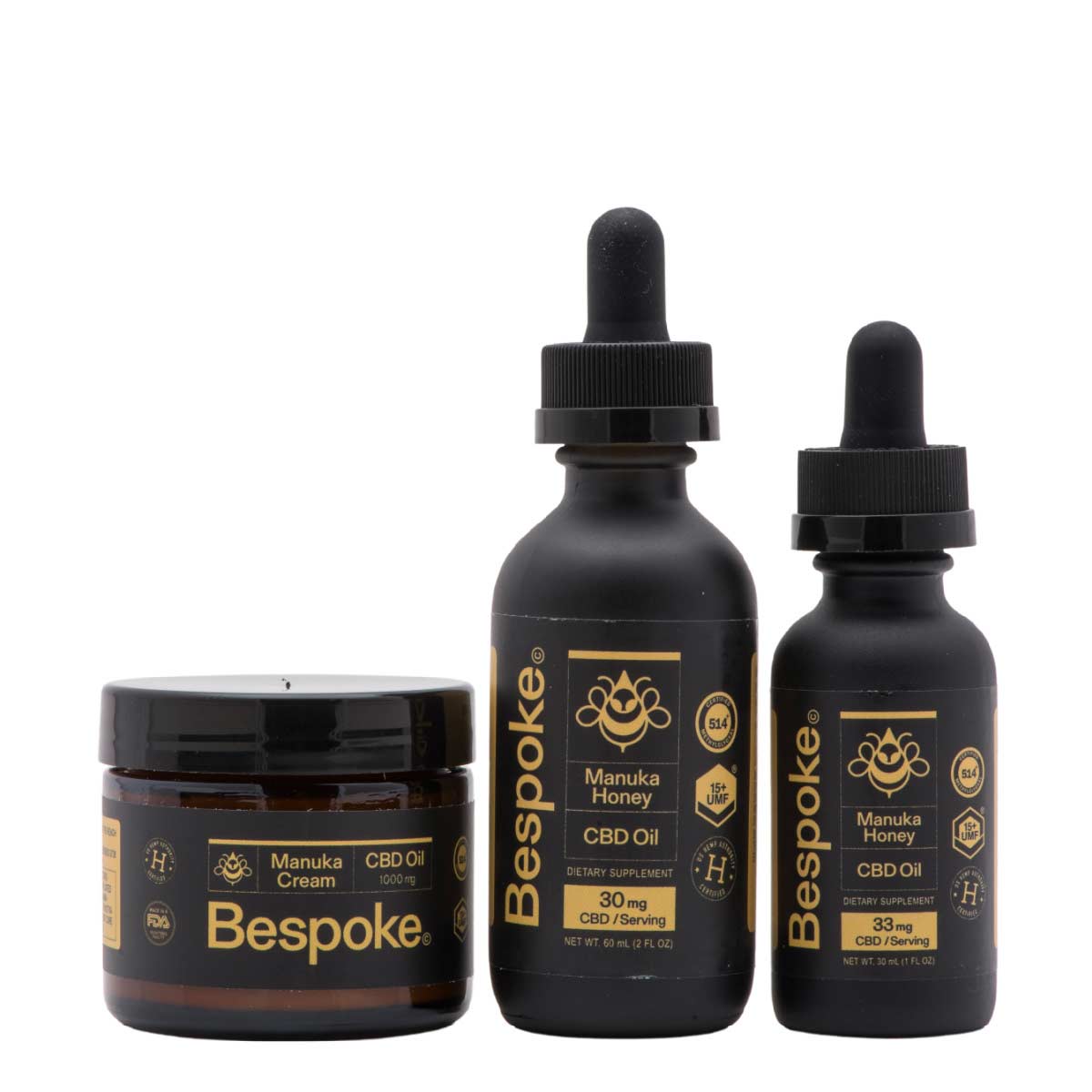
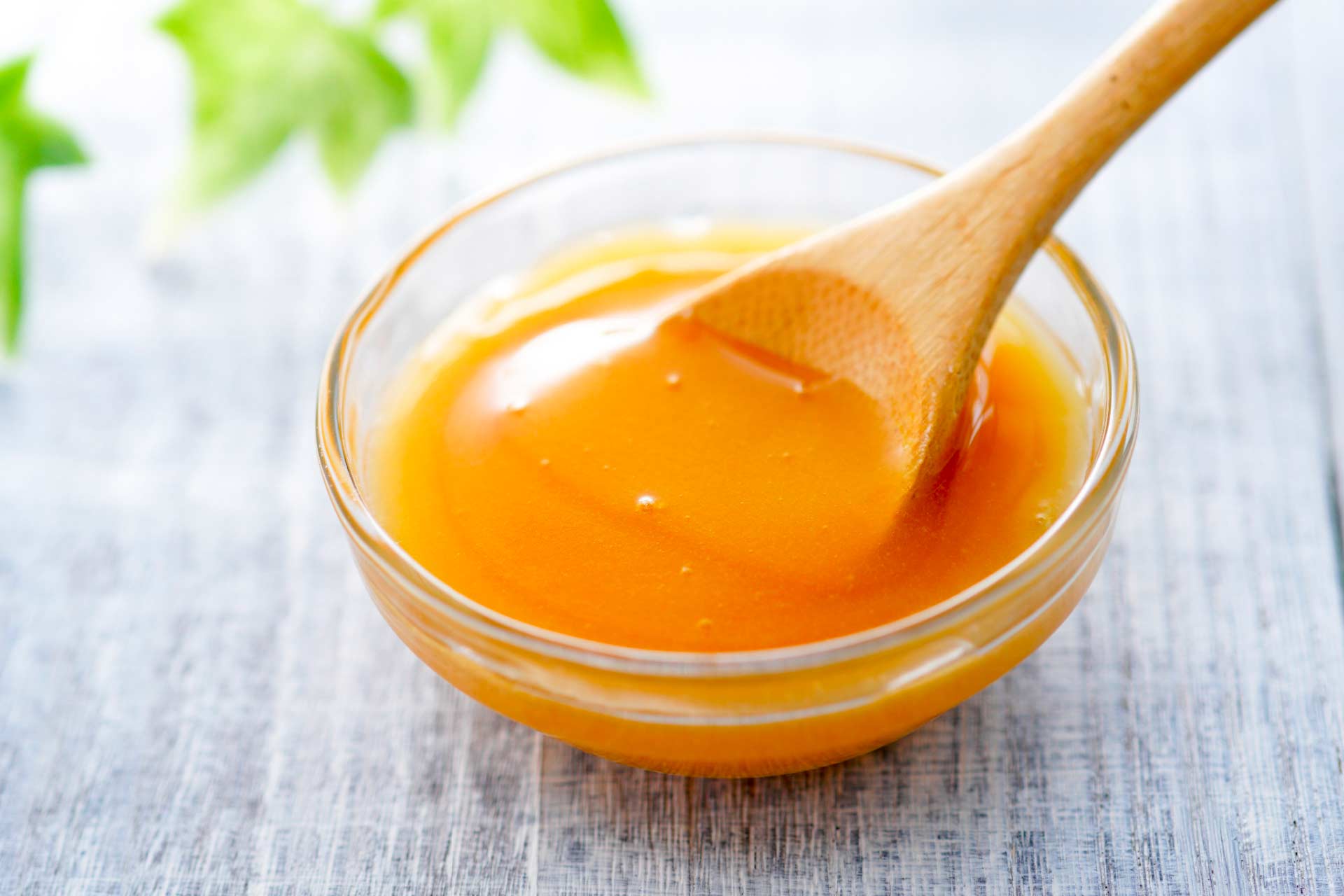
What makes Manuka honey different, and why quality matters
Manuka honey comes from bees that pollinate certain species of tea tree plants in Australia and New Zealand. The honey has a different appearance than you may be used to, with a thicker consistency and cloudy yellow color thanks to the bees’ diet. The bees’ diet also appears to give Manuka honey extra oomph when it comes to potential health benefits, but like with any other ingredient, quality matters.
“We import premium grade UMF 15+ Manuka honey directly from the source in New Zealand,” says Danny Pollack, Bespoke CEO. “There aren’t many other companies combining CBD and Manuka honey to begin with. Among the products that are available, ours is on the higher end when it comes to UMF grade, setting us apart from the competition.”
These new products join Bespoke’s line of hemp products containing CBD, CBG and CBN.
Danny pointed out the Manuka honey base is also very flavorful—his favorite way to consume it is in his tea.
“We offer several different flavors in other Bespoke hemp tinctures, including berry and citrus flavors. They taste great, but you still get that little bit of an aftertaste—that earthy hemp flavor that is off-putting to some people,” Danny said. “However, with the Manuka honey tincture, you really get the sweetness of the honey without that aftertaste of hemp. It smells and tastes great.”
Indeed, Manuka honey not only tastes good, but is also gaining attention for its unique chemical profile and health potential above and beyond other types of honey.
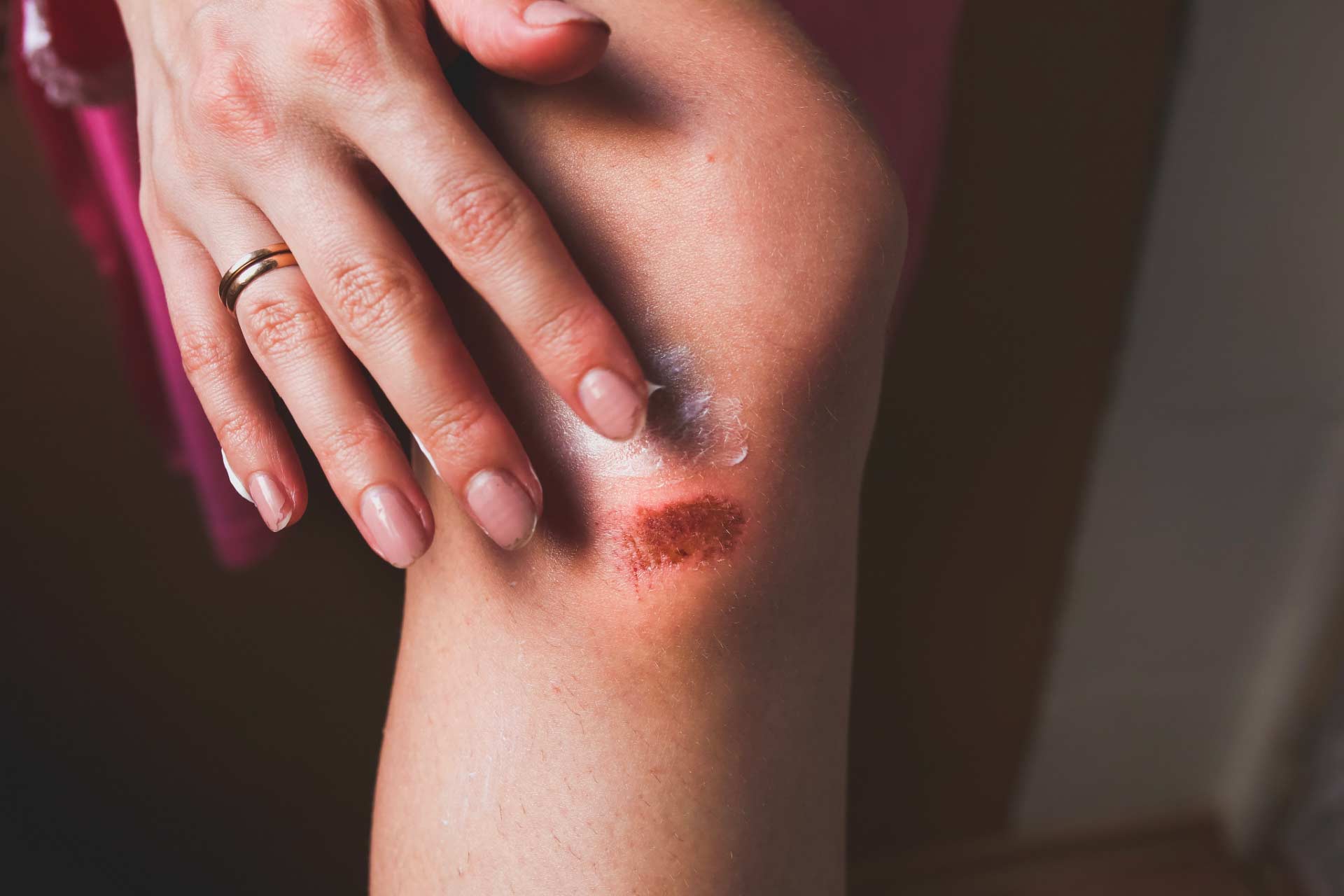
Benefits of honey for healing
Last summer, Leaf411 co-founder and CEO Katherine Golden, RN, learned firsthand about the healing power of honey when she volunteered with the City of Denver’s COVID testing program for the homeless population.
“The other nurses and I also volunteered in the day clinic which provides general medical care for the homeless. The most requested treatment was wound care. It was fascinating to see the use of honey sheets in the clinic to promote rapid healing,” Katherine said.
In fact, honey has been used medicinally for thousands of years to treat skin wounds and bacterial infections, though research has only recently begun to fully understand the underlying mechanisms.
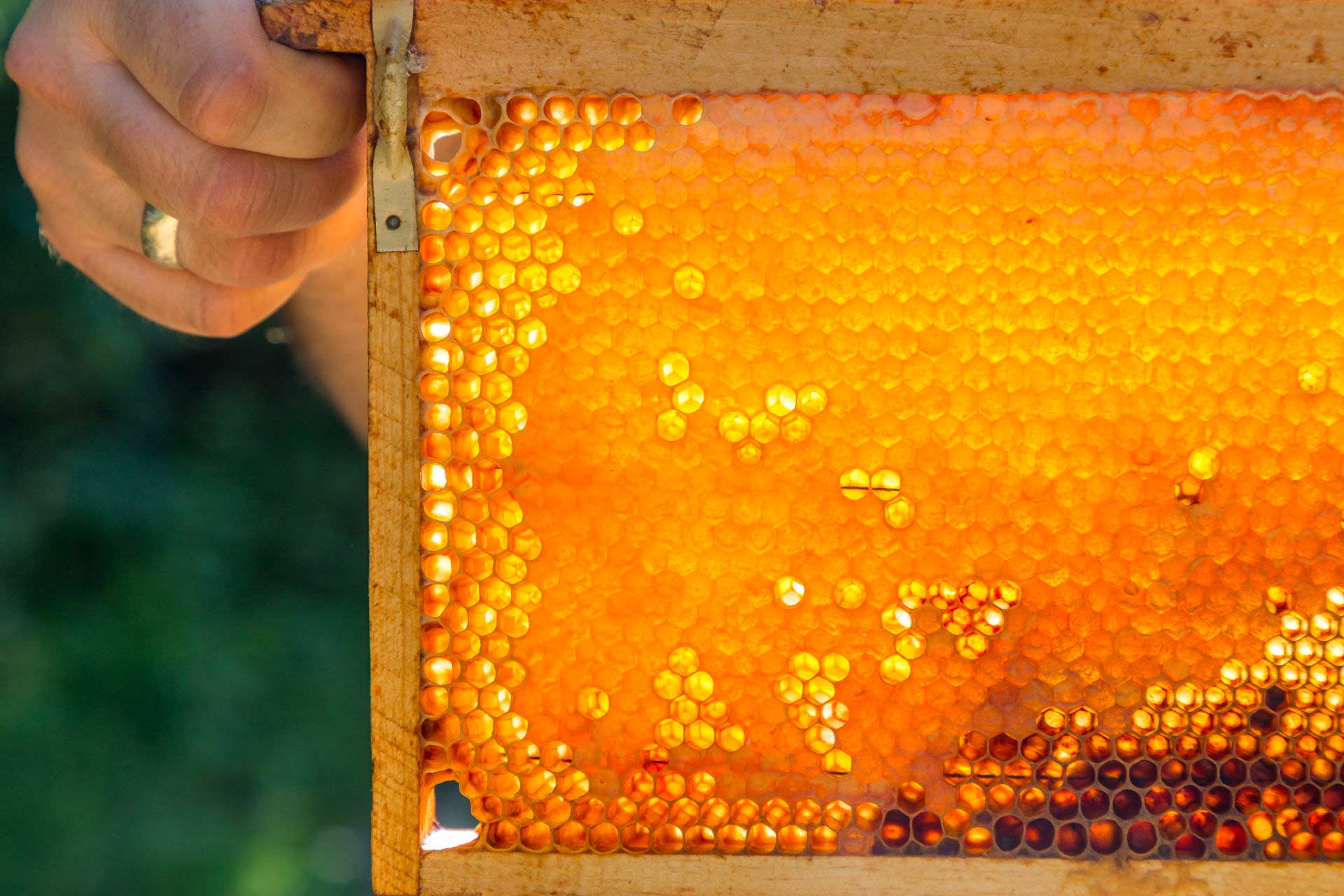
While honey may look like a simple product, studies have found that it’s quite complex, made up of over 181 different substances including natural sugars, vitamins, minerals, enzymes, amino acids, polyphenols and even hydrogen peroxide. Together, these ingredients have measurable antibiotic potential, as described in an International Journal of Microbiology article:
“Many factors have been shown to contribute to the antibacterial activity of honey, such as its high viscosity, mostly due to a high sugar concentration and low water content, which helps to provide a protective barrier to prevent infection. In addition, the mild acidity and hydrogen peroxide content have obvious antimicrobial effects.”
Other research has shown that honey may have anti-inflammatory and antioxidant properties, can serve as a useful tool when managing coughs and GI issues, and also may help with mouth sores that occur as a side effect from radiation therapy.
What level of Manuka honey is best?
Of course, not all honey is the same. The bees’ diet, along with environmental factors, impact honey’s antibacterial properties.
Even within the world of Manuka honey, quality matters, with a UMF grading system used to indicate the potency and antibacterial activity of the honey. The UMF rating can range from 5 to 25+, with a higher number indicating more of the beneficial compounds are present. You can learn more at this link.
Bespoke Extracts uses premium UMF 15+ Manuka honey sourced directly from New Zealand, which contains optimal levels of leptosperin, methylglyoxal (MGO), and other compounds that are unique to this product and contribute to its anti-inflammatory and antibacterial properties.
How to use Manuka honey infused CBD for wellness and recovery
Both hemp and Manuka honey share anti-inflammatory and anti-bacterial properties, so it’s not surprising to see the two ingredients appearing more frequently together in products geared toward wellness and recovery.
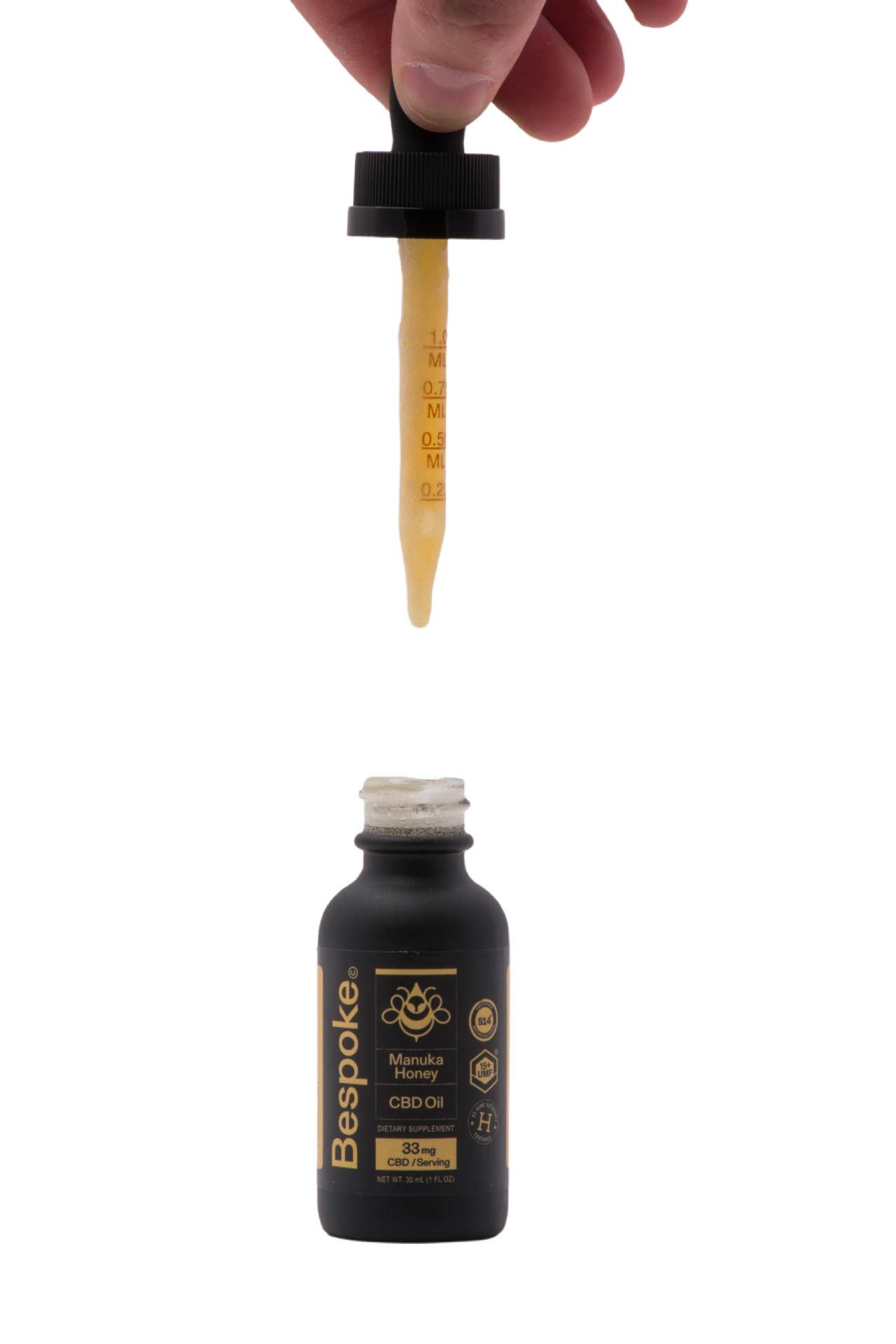
CBD Manuka honey tinctures work much like other traditional hemp CBD tinctures, providing more generalized relief from chronic conditions like pain, inflammation, insomnia and anxiety.
- Most people will feel effects within 30-90 minutes, with effects lasting 4-6 hours.
- If you are new to CBD, it is best to start with the lowest dose possible (we recommend 5mg).
- Not feeling effects yet? We suggest sticking with the same dose for at least 3 days Before increasing your dose.
- Build up your dose by adding 5mg every 3 days and slowly work your way up until you achieve symptom relief.
- If you are experienced at using CBD tinctures, you can start with your current dose or even a little less and work up from there. Not all products are created equal and taking a little less to start helps avoid potential side effects.
- Some people may find that CBD tinctures cause drowsiness, diarrhea or appetite changes. We suggest first trying new CBD products at home when you don’t have a busy schedule, just in case you have any of these side effects.
Honey, just like CBD and many other natural compounds, may interact with other medications, in particular anticoagulants like clopidogrel (Plavix) and warfarin (Coumadin), as well as certain anti-platelet drugs. If you are unsure whether your medications will be affected by CBD-infused Manuka honey, call our Leaf Nurses at 844-LEAF411 (844-532-3411) for answers to your questions, at no cost to you.
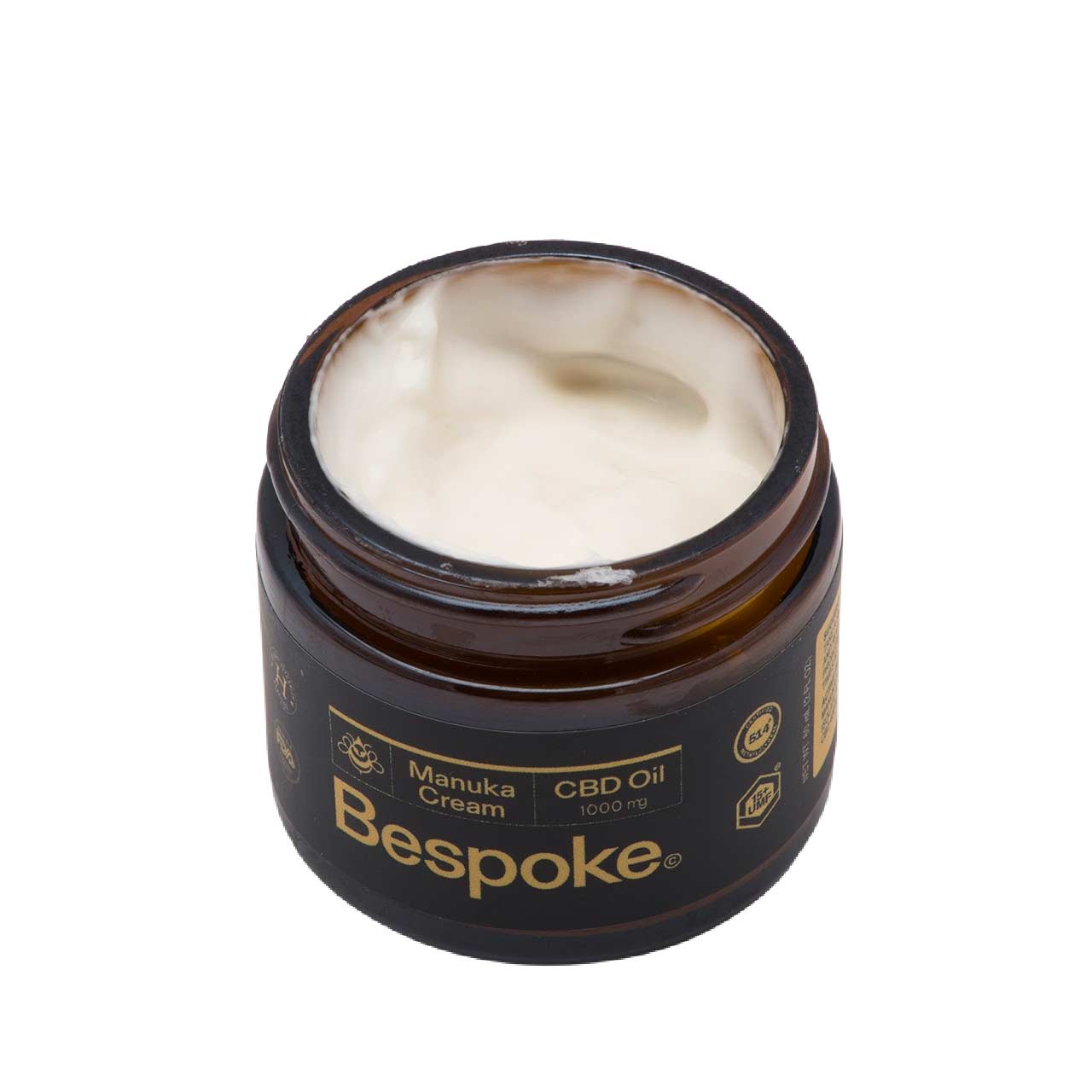
The combination of Manuka honey and CBD in products like Bespoke UMF15+ Manuka Honey Infused CBD Cream allow for anti-inflammatory benefits and pain relief without side effects that can possibly occur with ingestion. Topicals also provide a good option for targeted relief on the go, helping to relieve itching and soothe sunburns and other minor burns, as well as providing gentle relief for achy joints, muscles or other painful areas.
- Apply CBD Manuka honey topical cream to the affected area. Most people feel relief within 15-20 minutes, with the effects lasting several hours.
- Keep in mind the other ingredients in any topical products you use. Bespoke UMF15+ Manuka Honey Infused Manuka Cream also includes natural menthol and peppermint oil, so you should expect a cooling effect.
In fact, one thing we really appreciate about all of Bespoke’s products, including their CBD, CBG and CBN lines, is that they include a full list of ingredients and Certificates of Analysis (COAs) on their website.
Bespoke also offers discounts for frontline workers, U.S. military veterans and people aged 55 or older, as well discounts for shoppers who sign up for emails. Check out the Bespoke homepage for more details.
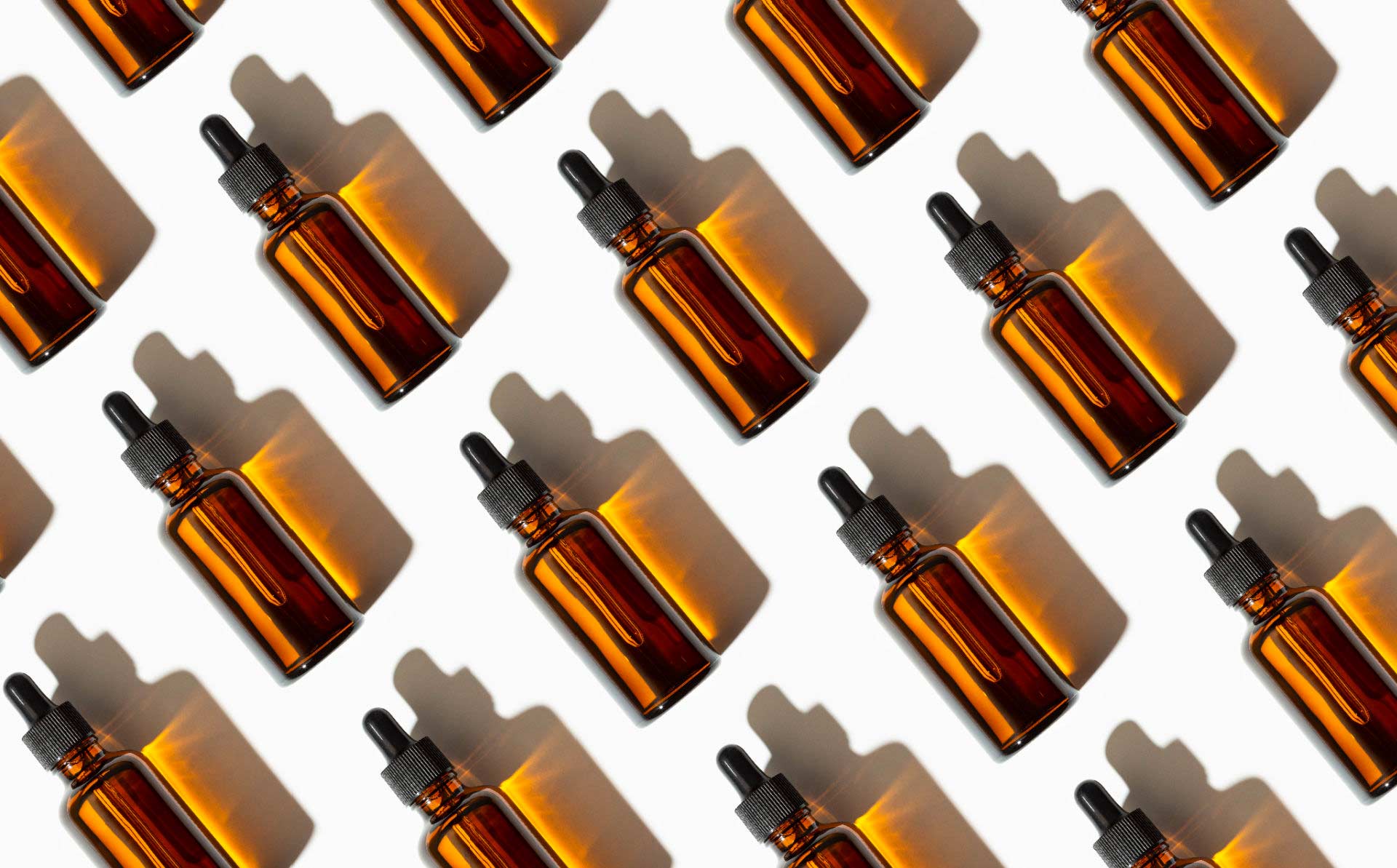
Sorting through today’s hemp CBD options
Manuka honey is only one of many natural ingredients showing up in today’s hemp products. While these products offer exciting potential, we recommend starting low with your dose and going slow to find your optimal dose.
Also, we recommend consulting with your primary care provider before adding CBD, Manuka honey or other supplements to your regimen to ensure there are no potential medication interactions or other concerns like an allergy to honey.
Our fully-licensed Leaf RNs can also help answer your questions at no cost to you. Call the Leaf411 hotline at 844-LEAF411 (844-532-3411) or chat us from our home page during hotline hours, Monday-Friday from 8:00 a.m. to 7:00 p.m. MDT.
The Leaf411 cannabis nurse hotline provides free, anonymous education and directional support to the general public about the safe use of legal cannabis. We partner with select business members who meet our rigorous standards to extend our education and outreach efforts.
How to Store Your Hemp CBD Products
We talk to experts about CBD expiration dates, and get their tips for storing hemp CBD for product potency and lifespan
Medically reviewed by Katherine Golden, RN
Written by Denise Rustning
We’ve all been there before—eyeing a recently expired hemp CBD product in our cabinet, wondering if it is still safe or if it will be as effective as when we first bought it.
This dilemma prompted us to ask manufacturers of high-quality hemp for their tips on storing CBD to ensure product quality and potency over time. We also asked about expiration dates, as well as what not to do when it comes to storing hemp CBD.
These hemp experts are made up of some of our own fully-vetted Leaf411 business members who manufacture hemp CBD products, as well as a few other industry leaders suggested to us by Alan Greenberg, Founder and CEO at CBD Garage. (See the bottom of this post for a complete list of hemp industry professionals who shared insights.)

Hemp CBD products stored in a cool, dark area. Products pictured include Wana Wellness Rest fast-acting hemp CBD tincture, BeSpoke Manuka honey-infused CBD tincture, trupura CBD Relief Cream, and Elixinol Omega Turmeric CBD capsules.
Top tip: Store hemp CBD in a cool, dark, dry area
Across all hemp CBD categories, the hemp experts agreed that storing products in a cool, dark area improves product lifespan. Fortunately, most hemp CBD products are packaged in amber or solid-colored containers that block light, making it easier for consumers to ensure a dark environment.
A dry environment can help prevent mold; however, with hemp CBD flower, an overly dry environment like the refrigerator can cause the product to dry out prematurely. (See below for tips on storing hemp flower.)
Avoid sunlight, heat and excessive exposure to air
Heat and sunlight are the biggest culprits when it comes to CBD degradation. While it may seem easy enough to avoid storing your hemp CBD under these conditions, it’s worth paying attention to special situations, like when you bring your hemp CBD with you when traveling.
CBD can also break down faster when exposed to air for a long time due to oxidation—for example, if a hemp product is left open on a countertop for days at a time. To prevent this from happening, you will want to store your hemp CBD in its original container with the lid tightly closed.
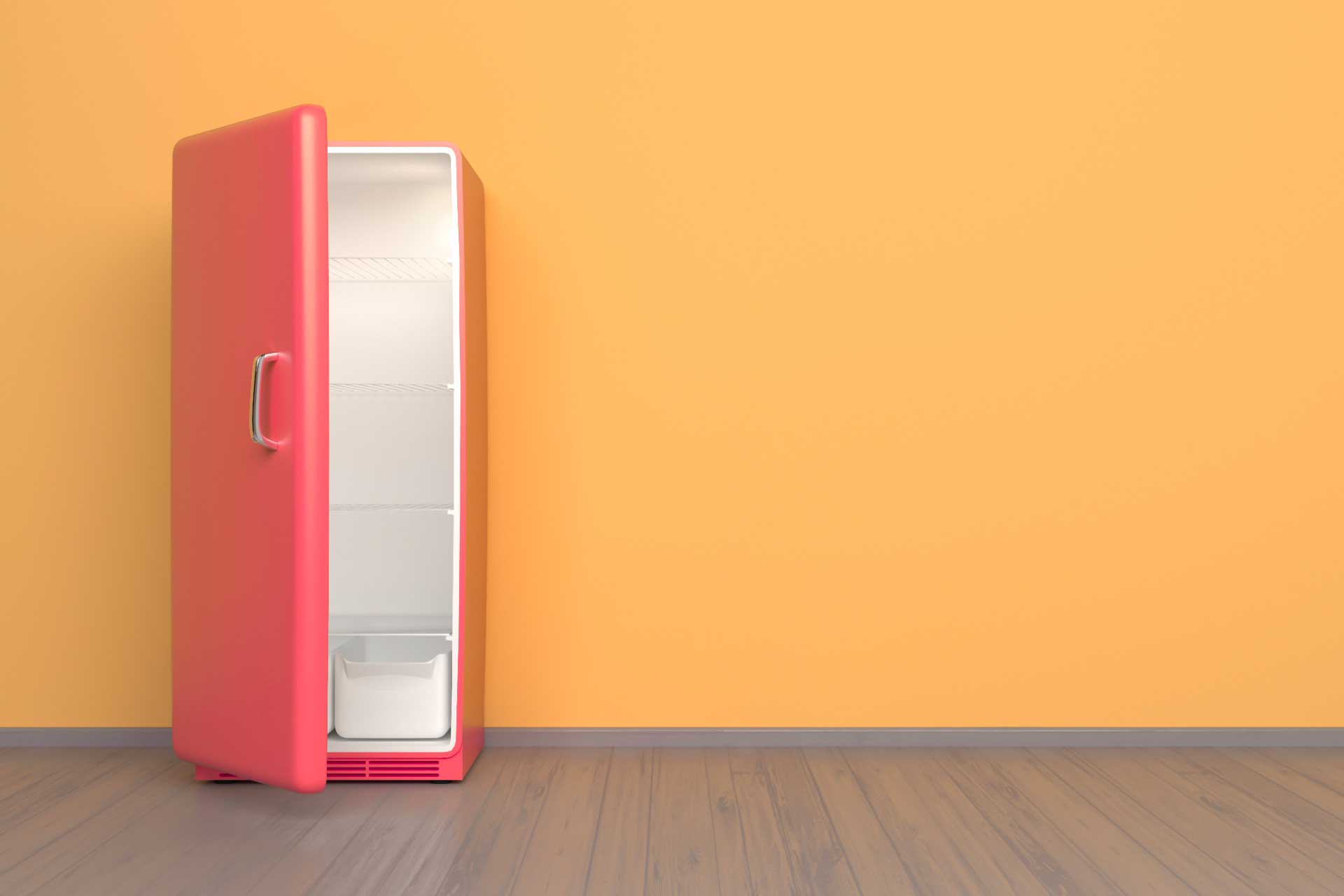
How cool is cool enough?
We can hear what you’re thinking: “When you say ‘cool,’ just how cool is that? Is it better to store my CBD in the fridge?”
Room temperature works perfectly well for most hemp CBD products. Cannabinoids from the hemp plant (CBD, CBG, CBN and others) are oily by nature. Most oils, including CBD oil, are shelf-stable at room temperature and do not require refrigeration.
Also, many hemp CBD tinctures use MCT oil, safflower oil, grapeseed oil, or olive oil as carrier oils—the base that the CBD is added to. You can think about how these oils are commonly stored unrefrigerated on dark pantry shelves—the same rules apply to CBD hemp products made with these ingredients!
In fact, in some cases, an oil-based hemp CBD tincture liquid may become too thick or difficult to use if refrigerated.
On the other hand, for some products like pills and capsules, refrigeration could extend the product’s lifespan. For example, Lauren Stall from Trill Pills says, “We only state to customers one-year shelf stability out of the fridge since that is certified by the state. However, my personal experience is that Trill Pills can be kept in the fridge for longer with no deterioration.”
Does hemp CBD stay good past its expiration date?
For hemp CBD products made in Colorado, the state sets a standard one-year shelf-stable expiration date. However, most high-quality hemp products may remain good for up to a year after the expiration date has passed as long as they have been properly stored.
Now that we’ve covered some general questions, let’s dive into the best ways to store hemp CBD tinctures, edibles, topicals, flower, vapes and transdermal products.
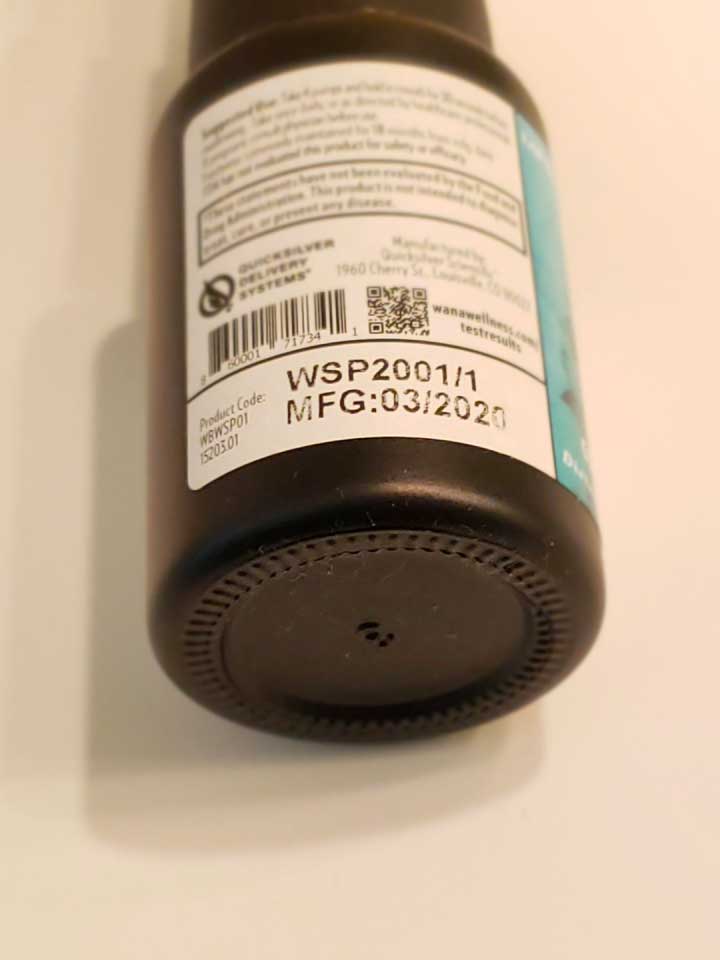
Wana Wellness Rest Quick hemp tincture bottle showing manufacture date. The tincture utilizes nanotechnology to more rapidly deliver CBD. More info here.
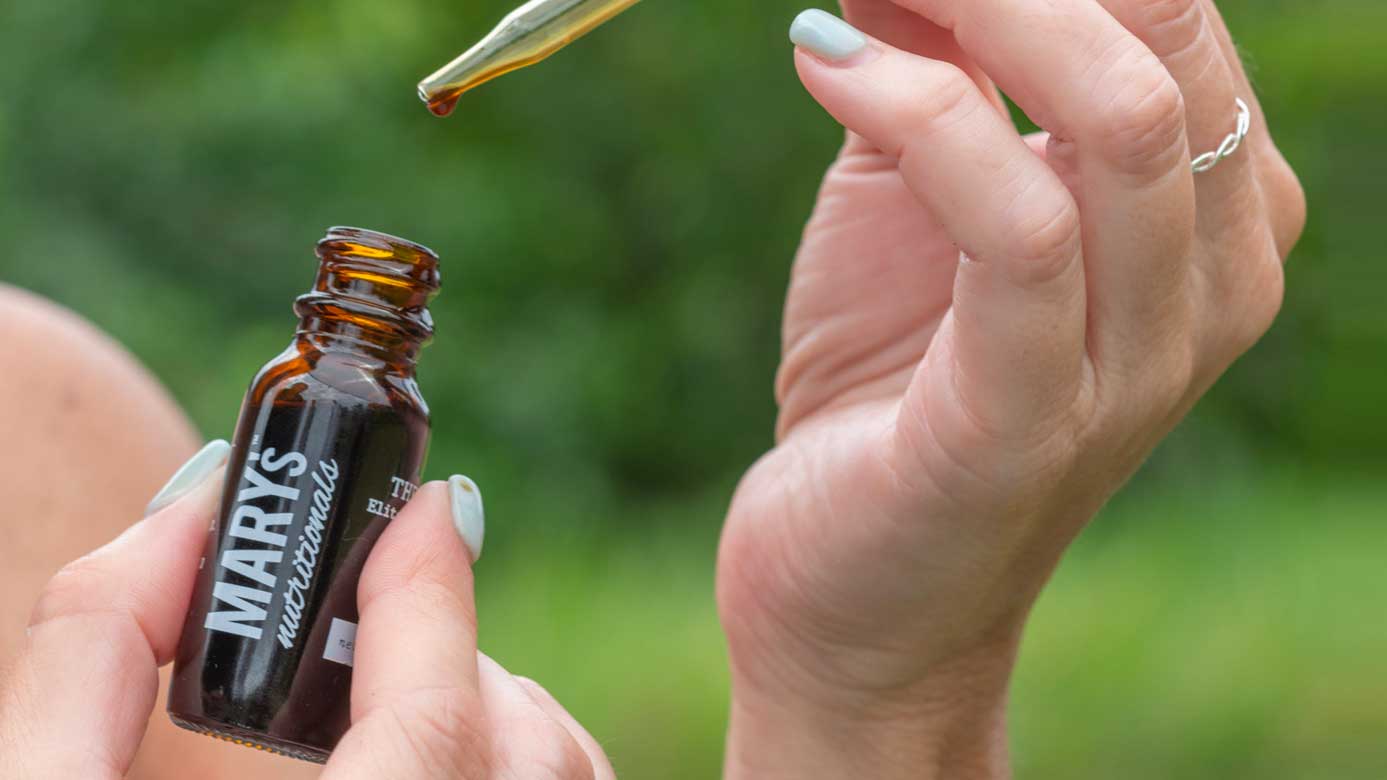
Mary’s Nutritionals Remedy full-spectrum hemp CBD tincture. More info here.
How to store hemp CBD tinctures
- Store in a cool, dark, dry area. (One exception is Wana Wellness Quick hemp tinctures, which can handle warmer temperatures due to their proprietary manufacturing technology.)
- Avoid leaving tinctures in sunny areas like on a windowsill or in a hot car.
- Shake tincture before using.
- When using a tincture dropper, do not let it touch your tongue or mouth where it could pick up bacteria that would then be transferred to the bottle. If your dropper touches your mouth or other unsterilized surfaces, it can be cleaned using soap and water and rinsing thoroughly before returning it to the bottle.
How to store hemp CBD edibles
- CBD gummies, chocolates and other hemp-infused edibles are just like any other food product when it comes to storage and product lifespan. The hemp CBD is relatively stable, but other ingredients may have additional considerations. For example, Mike Hennesy, VP of Innovation at Wana Wellness, points out that gummies may begin to dry out and lose their soft consistency over time, particularly in arid climates in places like Colorado or Arizona.
- Make sure packaging is always tightly closed to help reduce product drying out. For items like a half-used chocolate bar, store the remaining product in a sealed ziplock bag.
- If an edible tastes or smells “off” or has mold on it, throw it out. You may also want to contact the manufacturer if you believe the product spoiled prematurely despite being correctly stored.
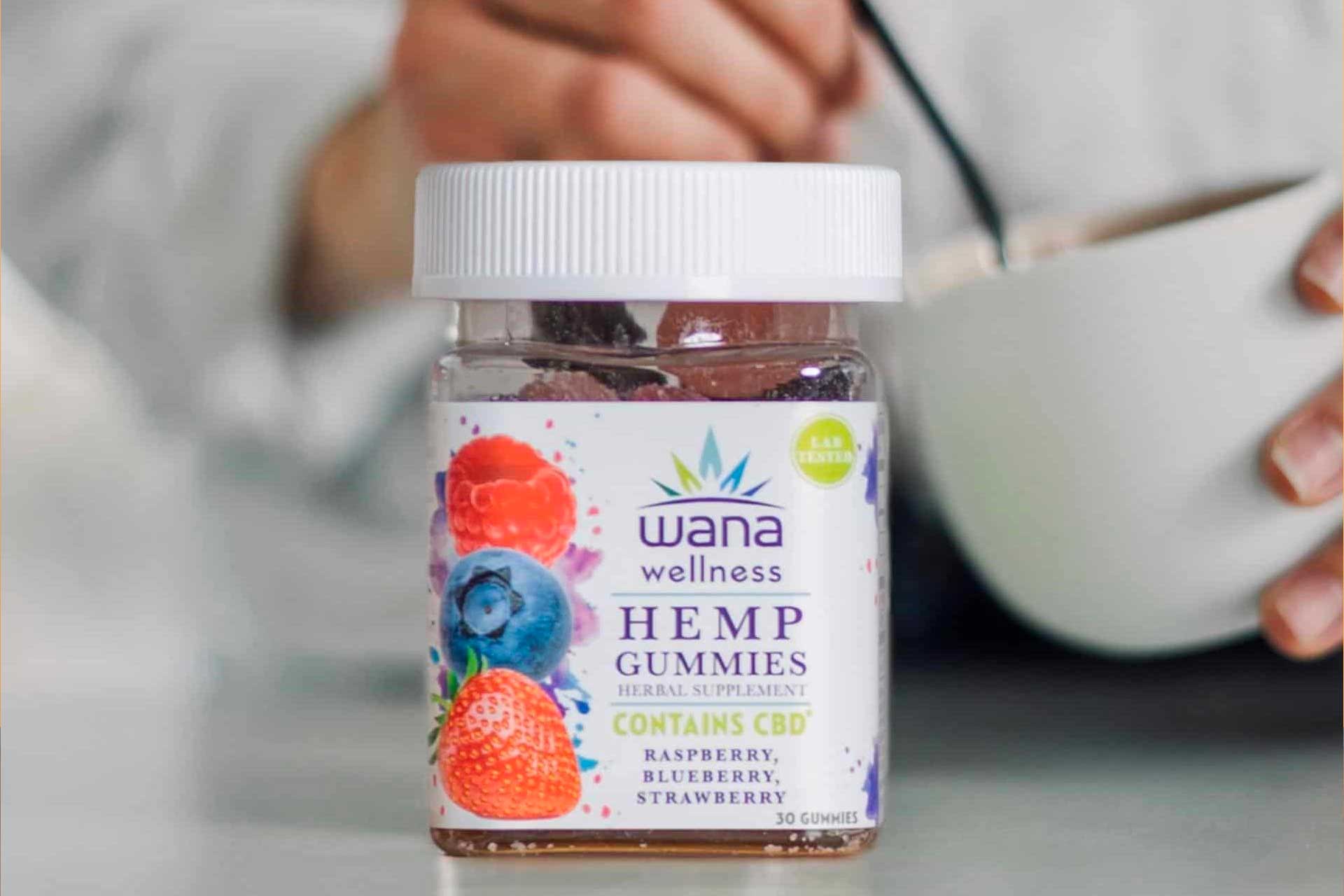
Wana Wellness Mixed Berry hemp gummies. More info here.
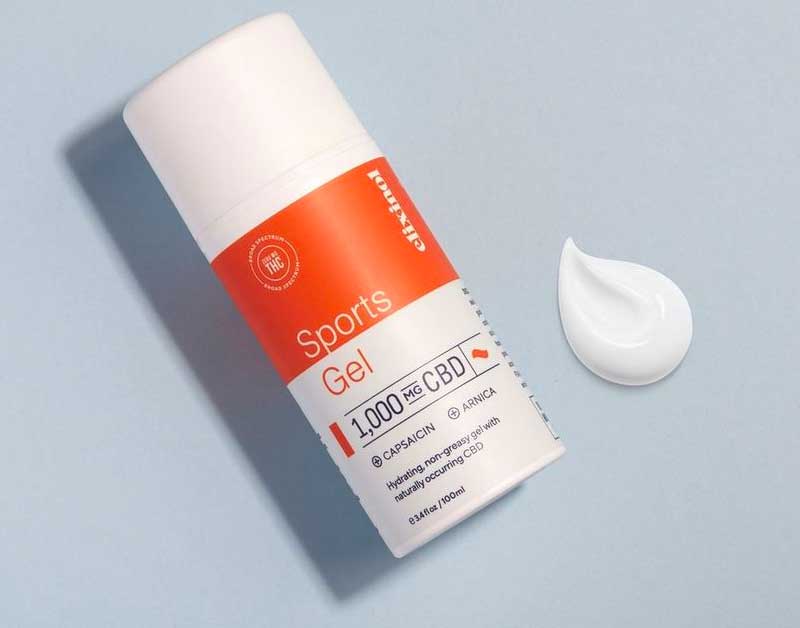
Elixinol Sports Gel topical containing CBD, capsaicin, arnica and other botanicals. More info here.
How to store hemp CBD topicals
- Store at room temperature away from direct sunlight.
- Always replace and tighten the lid on the container after use.
- If possible, use an applicator like a tongue depressor or firm cotton tip to scoop topicals out of a jar, instead of using your fingertip. This will help prevent bacteria from your hand getting into the product.
How to store CBD transdermal patches
- Store at room temperature away from direct sunlight.
- Use the transdermal patch soon after opening the package, or put the unused patch in a sealed ziplock bag away from light.
- If you are cutting a patch in half or quarters for a smaller dose, then store the remaining unused portion in a sealed ziplock bag, says Jeremy Riggle, PhD, Mary’s Nutritionals. “If stored correctly, the patch portions will stay good for up to a year. If the half or quarter sections are not stored properly, then its shelf life drops to a few months.”
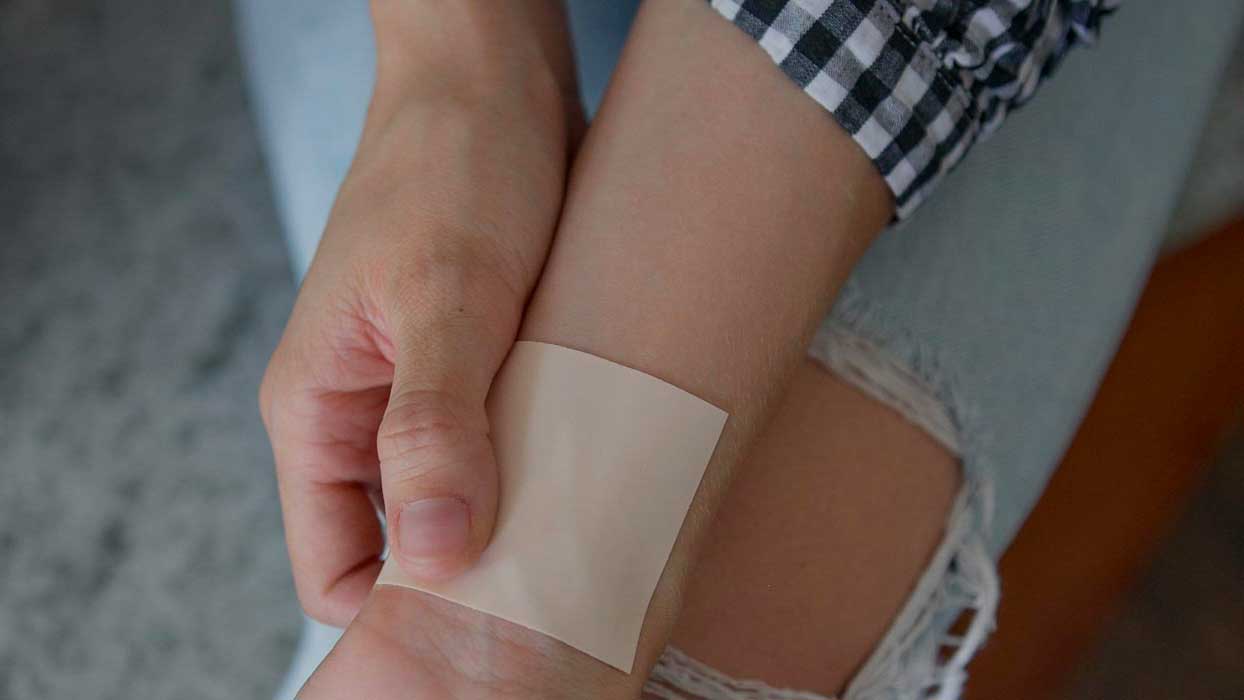
Mary’s Nutritionals hemp CBD transdermal patch allows cannabinoids to be absorbed continuously throughout the day. More info here.
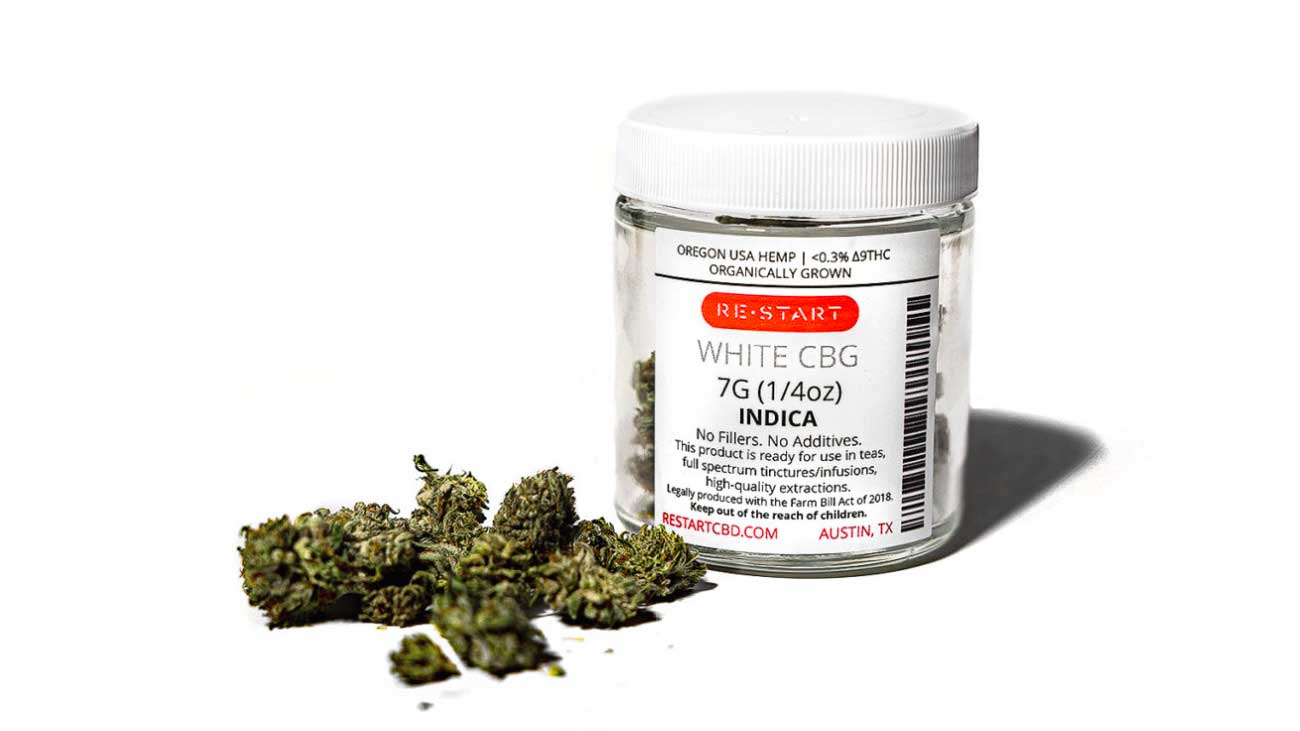
RESTART CBD hemp flower which can be smoked or vaped to provide faster onset and offset of hemp CBD effects. More info here.
How to store hemp CBD flower (buds) for freshness
- Store in an airtight glass container in a cool, dry area.
- Avoid storing in direct sunlight.
- For a partially smoked hemp pre-roll, snuffing it out by putting it in an airtight container (glass jar or the plastic tube it came in) is better than stubbing it out (grinding the end on a hard surface the same way people put out cigarettes) according to RESTART CBD co-founder and CEO Shayda Torabi. Airtight storage tubes can be found online by searching the term “doob tube.”
- When it comes to humidity and rehydrating bud, some people turn to humidity packs; however, Torabi urges caution, noting that if not used correctly, humidity packs can cause hemp CBD flower to mold, making it unsafe to use. “If you want to re-hydrate your bud, do it with small amounts of flower you are going to use within 48 hours. Don’t leave your humidity pack in the jar with your flower for extended periods of time, and make sure to follow the instructions on the humidity pack to ensure the best experience,” Torabi says.
How to store CBD vapes
- Store in a cool dry area, in an upright position to reduce the risk of leakage.
- Do not leave your vape in a car since extreme temperatures can impact the consistency of the vape liquid, as well as product quality.
Other product ingredients also make a difference
Your favorite CBD chocolate bar or flavored tincture contains hemp-derived cannabinoids, but it also contains other ingredients that impact shelf stability and overall product lifespan. Other ingredients—water-based ingredients in particular—can limit product lifespan in some cases.
Ryan Lynch, co-founder of Boulder Hemp, explains that high water content more readily supports microbial growth if the product has not been pasteurized or sterilized. Oil-based products, on the other hand, should last longer due to the lack of water content.
You only need to look as far as your kitchen to see examples of how water content impacts shelf life. Most foods with higher water content, like fruits and meats, have a shorter lifespan. They are either stored in a refrigerator or are canned, which sterilizes them and makes them shelf-stable until they are opened.
On the other hand, cooking oils are stored at room temperature even after opening. The lack of water, combined with a lack of sugar or other ingredients, makes ingredients like olive oil and MCT oil shelf-stable at room temperature for long periods of time. These are the same oils used in many hemp CBD tinctures.
In short, when thinking about how to store your hemp CBD, check the manufacturer guidelines and consider all the ingredients in your product to help guide you.
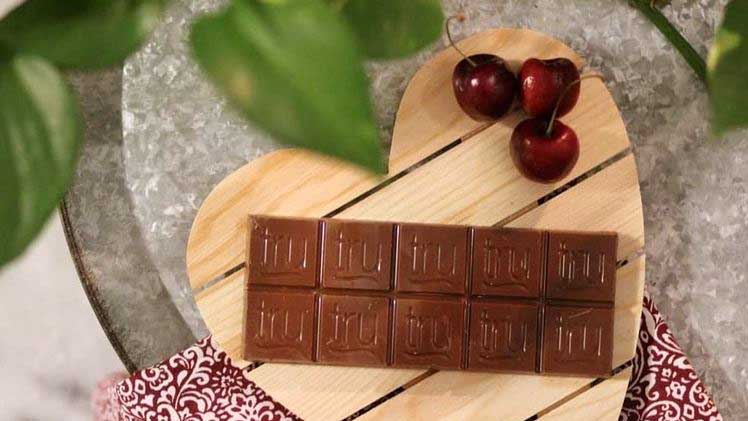
trupura CBD chocolate-covered cherry flavored chocolate bar. More info here.
Need hemp CBD answers? We can help at no cost!
Our Leaf Nurses are happy to answer your hemp CBD questions about any product on the market today—the brand does not need to be one of our member businesses, either. Call our free hotline at 844-LEAF411 (844-532-3411), or chat us from our home page during hotline hours, Monday-Friday from 8:00 a.m. to 7:00 p.m.
Hemp CBD manufacturers and retailers who shared tips for this post: Alan Greenberg, CBD Garage; Mike Hennesy, Wana Wellness; Jeremy Riggle, PhD, Mary’s Nutritionals; Shayda Torabi, RESTART CBD; Erika Sauerwein, Elixinol; Abigail Nueve, trupura CBD; Ryan Lynch, PhD, Boulder Hemp; Lauren Stall, Trill Pills
The Leaf411 cannabis nurse hotline provides free, anonymous education and directional support to the general public about the safe use of legal cannabis. We partner with select business members who meet our rigorous standards to extend our education and outreach efforts.
Leaf411 Supporter Spotlight: Lori Peck, Founder and CEO of CAASI CBD

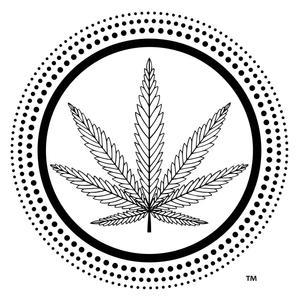
Medically reviewed by Katherine Golden, RN
Written by Denise Rustning
Leaf411 recently added our first supporting member from the State of Oregon—CAASI CBD!
While our vetting process is more virtual than in the past, we were impressed with CAASI founder and CEO Lori Peck’s story about why she started her company, as well her commitment to transparency throughout the manufacturing process.
(Just a reminder: Hemp-based CBD was made federally legal by the 2018 Farm Bill which allows it to be sold online and shipped to all 50 states. In order to meet the law, CBD hemp must contain less than 0.3% THC. This is such a small amount of THC that most people don’t feel any intoxicating effects from it.)
CAASI products contain CBD isolate, which doesn’t include any THC at all. Keep reading to learn more about Lori’s motivation for developing CAASI CBD, along with what makes her product different from CBD oils you might find at the grocery store.
Moving Past Stigma to Healing
Like many people, Peck was initially skeptical about anything related to cannabis.
“I bought into the stigma of cannabis. I didn’t know anything about it and hadn’t tried it since high school when I discovered that I’m very sensitive to THC,” Peck said.
A cancer diagnosis, along with several other life-changing events, inspired Peck to take a second look at CBD hemp’s potential to boost wellness. She found that it made a difference in her own life.
Based on her own experience, Peck was exploring the idea of putting together cannabis care kits for people who were fighting cancer. She began seeking out others who shared their expertise and discovered Hustle Hard: For Women Who Mean Business, a three-day intensive designed to launch female cannabis entrepreneurs. Hustle Hard has since grown into Females to the Front.
For Peck, the Hustle Hard event was transformative. “I was blown away by the amazing smart women that I met, including chemists, scientists, nurses and doctors working in the cannabis industry. Between my own experience using CBD hemp products and what I learned at Hustle Hard, I decided this was where I wanted to focus—developing clean, plant-based products that contain as few ingredients as possible,” she said.
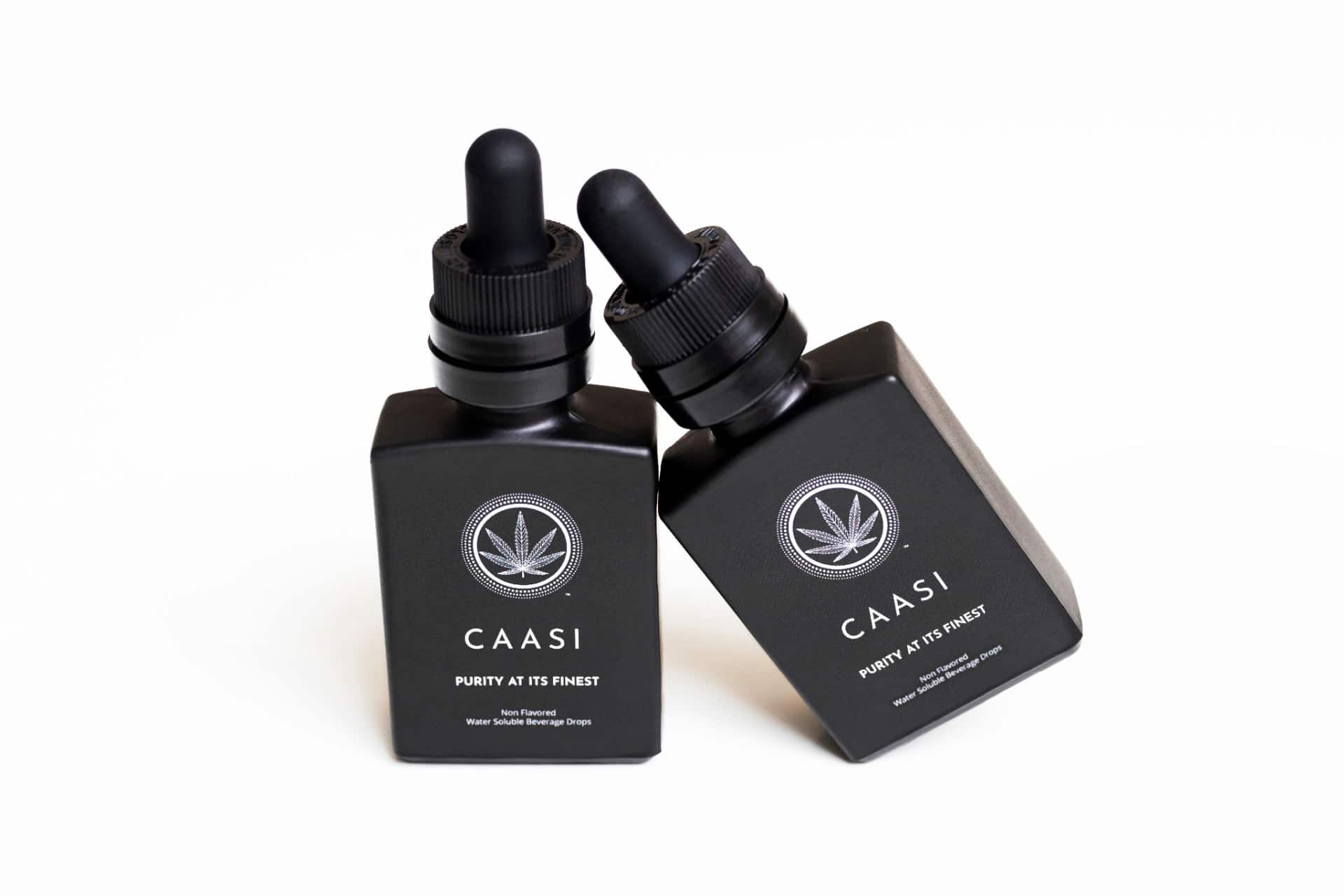
Pivoting into Purpose-Driven Work
Peck majored in fashion design and spent years in corporate retail before launching CAASI.
“It was not my lifelong dream to be in corporate retail, but I gained a lot of experience on how to run a business. At the same time, my work lacked purpose. People don’t need new t-shirts all the time,” Peck said.
“Now, I’m doing work that I love, proving something that will be helpful for people,” she said.
Sourcing the Best CBD Available
Not all CBD is the same. That cheap bottle of CBD you find in the convenience store may only contain a fraction of the promised CBD, or it may have been manufactured using low-quality hemp.
Honest, high-quality CBD companies, on the other hand, are committed to sourcing hemp that utilizes industry best practices. They are also transparent, describing their processes and providing Certificates of Analysis (COAs) showing the results of third-party testing. CAASI is a prime example of a company doing CBD the right way.
“We start with hemp from Horn Creek Farm in Southern Oregon, where you’ll find some of the richest soil in the state,” Peck said. “They’re not FDA certified organic, but they use organic farming practices. They are just really good people.”
Sonically-Vibrated CBD to Improve Absorption
The hemp flower that Peck sources from Horn Creek Farm then goes to Scientia Labs for extraction. Transparency and scientific rigor are both central to Scientia Lab’s work.
“Scientia Labs isolates the CBD from the hemp. The CBD is broken down into a powder, and then that powder is mixed with organic MCT oils and just a few other ingredients,” Peck explained. “The challenge is that when you have oils, they don’t easily mix with liquids. That’s where the sonic vibration process makes a difference. When the product is sonically vibrated, it breaks the liquid down into nanoparticles that more readily mix with liquids, and which can be absorbed into your system much easier.”
This process also results in a product that lacks the bitterness of many CBD isolates.
Peck said, “A lot of isolates can tend to leave a bitter taste in your mouth, but the CAASI CBD drops mild enough that you can even use them in water. They’re also very versatile, since they’re unflavored.”
Partnering with Leaf411 on Education You Can Trust
“At CAASI, we recognize that education is important, especially for people who are new to CBD. We do our best to align ourselves with experts like Leaf411 who are really knowledgeable and have the professional background to answer questions about medication interactions, for example,” Peck said. “It also provides credibility for us to be able to say we’ve completed your vetting process and meet the standards for a product that a clinical professional might suggest.”
Check Out CAASI at Our Upcoming Leaf411 Learning Series Launch!
CAASI will be joining the upcoming Leaf411 Learning Series Launch on August 20, 2020, as one of the vendors in our virtual expo hall. Stop by the booth to say hello and learn more about how CAASI’s CBD drops are different. Sign up for our our Learning Series at this link: https://hopin.to/events/leaf-learning
CAASI will also be featured in an upcoming MJ Lifestyle VIP Plant Wellness Subscription Box, and will soon be available in select retail locations in the Portland, Oregon, area. Remember that you can also order trial size or full size products directly from their website.
Helping You Find CBD Products and Information You Can Trust
At Leaf411, our commitment is to you—the public. Whether you’re looking for CBD products you can trust, or medically-sound information on CBD, we can help. Call our anonymous nurse-staffed hotline for free at 844-LEAF411 (844-532-3411) or chat us from our homepage during hotline hours.
Also, we encourage you to subscribe to our newsletter so that you can be the first to learn about our upcoming initiatives. Sign up below!
CBD Hemp 101: Full Spectrum, Broad Spectrum, Distillate and Isolate
Medically reviewed by Katherine Golden, RN
Written by Denise Rustning
Are you confused by all the different types of CBD? Don’t worry, we’ve all been there before!
All cannabinol (CBD) starts off as a compound in either hemp or cannabis plants. The plants undergo various processes to extract CBD, resulting in a range of CBD products. We break down the main types of CBD below, along with the pros and cons of each type.
Full Spectrum CBD: Wide-Ranging Hemp Benefits
Full spectrum CBD oil contains most of the of the hemp plant compounds, including terpenes, flavonoids, essential fatty acids, CBD, cannabigerol (CBG), and trace amounts of tetrahydrocannabinol (THC), staying below the 0.3% federal limit for CBD hemp products. The plant compounds work together to create a synergistic entourage effect that can boost the benefits of the CBD hemp plant. Full spectrum CBD oil is often a green color, reflecting the presence of those compounds. The color and flavor can even change between product batches due to variations in the plants.
- Pro: Full spectrum CBD provides all the power of the hemp plant, available in a variety of product types from topicals, tinctures and edibles to vape concentrates, as well as crumble that can be dabbed (smoked with a special rig). It’s less processed than other CBD concentrate types, as well.
- Con: Full spectrum CBD contains trace amounts of THC (under 0.3%). While it’s not enough THC to be intoxicating, the verdict is out on whether it’s enough to trigger a positive drug test result. Also, because full spectrum CBD retains the original plant compounds, it has a natural flavor that some people may find off-putting. Many manufacturers add fruit or mint flavoring to their full spectrum products to balance out the flavor.
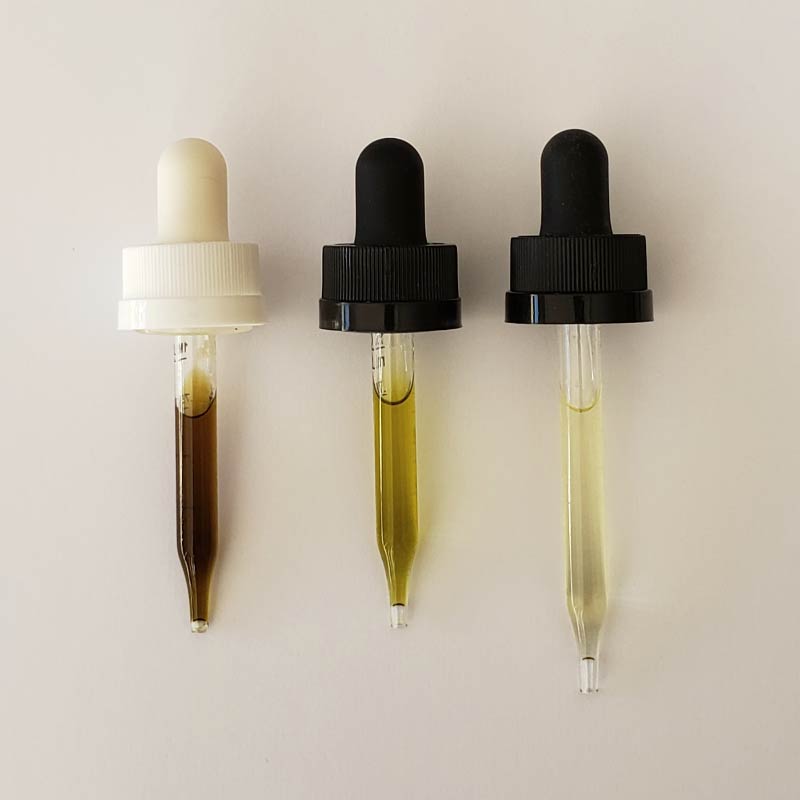
Broad Spectrum CBD: A THC-Free Option Loaded with Hemp Power
Broad spectrum CBD is similar to full spectrum CBD, except that the product goes through additional refinement to remove all THC. It’s important to note that the terms “full spectrum” and “broad spectrum” sometimes get confused, even by product manufacturers and marketers. Furthermore, past research has shown that product labeling can sometimes be inaccurate. Be sure to check the manufacturer’s test results on the product Certificate of Analysis (COA) to confirm this!
- Pro: Broad spectrum CBD maintains most of the plant benefits while eliminating THC, and can be used in the same ways that full spectrum is used. This may be an appealing option for people who want or need to avoid THC due to workplace drug testing; however, given the confusion around labeling, a safer option would be CBD isolate, which we discuss below.
- Con: Removing trace amounts of THC requires additional refinement which also pulls with it additional minor cannabinoids and lessens the CBD content in the process, moving CBD further away from its full plant form. Also, given the concerns around inaccurate labeling and testing, broad spectrum CBD is not the ideal choice for athletes and professionals who are subject to drug testing.
Distillate CBD: A Powerful Hemp Concentrate
Distillate CBD is a concentrate containing between 80% – 90% CBD. In order to make distillate CBD, additional steps take place to filter out impurities and remove most of the non-cannabinoid compounds, including terpenes, flavonoids and essential fatty acids. This process results in a product with a honey-like consistency that is odorless and tasteless.
- Pro: Distillate CBD retains the plant cannabinoids, including minor cannabinoids and THC (less than 0.3%). Distillate is often used in vape products, edibles and topical products given its high concentration, purity and lack of odor or taste. This results in a more consistent product.
- Con: Distillate CBD undergoes additional post-processing extraction. Also, it provides a narrower range of plant-based benefits when compared to full spectrum products.
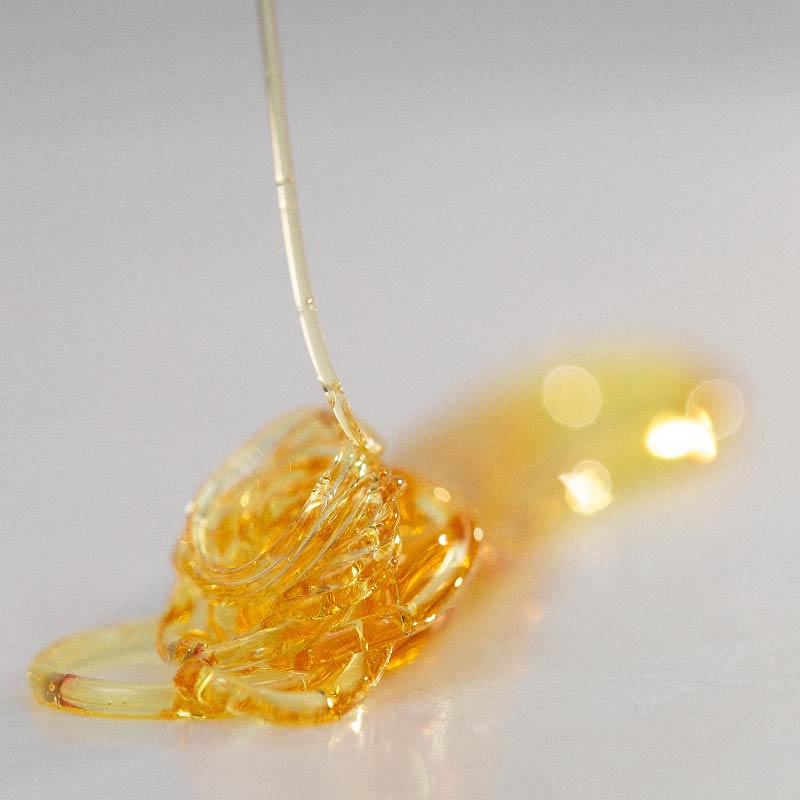
Isolate CBD: Pure Cannabidiol
Isolate CBD is the purest form of CBD available, consisting of approximately 99% CBD in white powder form. Unlike distillate, CBD isolate doesn’t contain any other cannabinoids or plant compounds. This makes it a favorite among people, such as professional athletes, who cannot risk ingesting even trace amounts of THC. Products made with isolate CBD are often labeled as “No THC,” though you’d want to check the Certificate of Analysis (COA) test results to ensure this is true.
Our Leaf411 nurses recommend using isolate CBD consumer products that are designed to provide consistent, pre-dosed administration, and which are manufactured by reputable companies, such as our member partners. While isolate CBD is also sold as bulk powder, we have concerns about product quality and dosing.
- Pro: Isolate CBD does not contain any THC, making it the safest bet for people who cannot risk positive drug tests. Manufacturers use isolate CBD that they mix into their drink products, foods (edibles), topical products or tinctures, while isolate CBD wax can be dabbed but should be used with caution.
- Con: The drawbacks are similar to those we discussed with distillate CBD. Isolate CBD’s purity means that many other beneficial plant compounds have been stripped out.
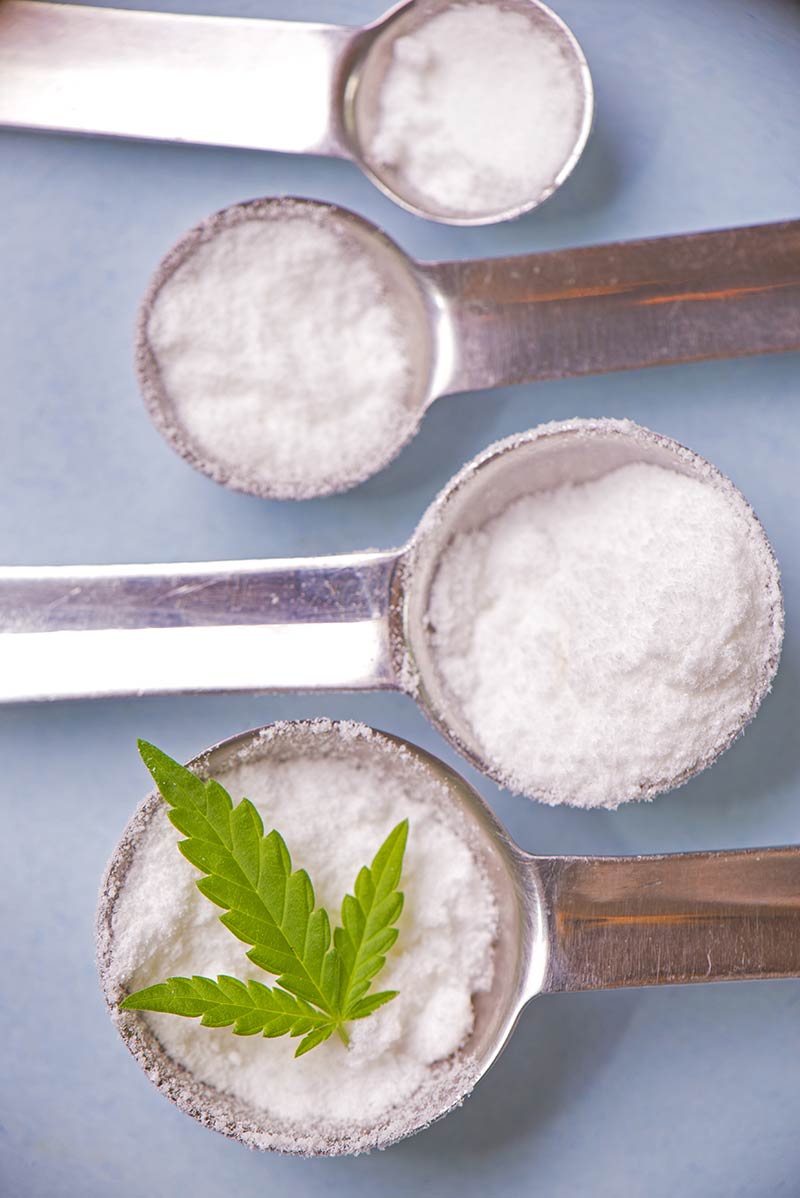
How to Choose the Best Type of CBD
We wish there was an easy cheat sheet or quiz for finding the best type of CBD. Beyond a few basic considerations, though, it can be a process of trial and error.
We encourage you to continue your journey into finding reliable, accurate CBD information from reputable sources. One of our favorite sources is ProjectCBD. You can find more CBD 101 information that we stand behind at this link.
Our Leaf411 cannabis-trained nurses are happy to provide guidance on the different types of CBD and how they might help address your specific needs. Call our free, anonymous hotline at 844-LEAF411 (844-532-3411) for medically-sound answers to your cannabis and hemp questions.
